Serendip is an independent site partnering with faculty at multiple colleges and universities around the world. Happy exploring!
Bio 202, spring 2009 - Notes

|
20 January
The challenge in detail, and in general
- Can Eye Color Have An Effect on Vision?, NYTimes, 19 Jan 2009
- Trying Everything and Anything for Autism, NY Times, 19 Jan 2009
- Purple Heart is Ruled Out for Traumatic Stress, NY Times 7 Jan 2009
- Psychiatrists Revise the Book of Human Troubles, NYTimes, 17 Dec, 2008
- Study Finds Drug Risks with Newer Antipsychotics, NYTimes 14 Jan 2009
- A Problem of the Brain, Not the Hands: Group Urges Phone Ban for Drivers, 12 Jan 2009
- A Love Vaccine, 12 Jan 2009
- Sex and Depression: In the Brain if not the Mind, NYTimes 19 Jan 2009
- My Genome, My Self, NYTimes, 11 Jan 09 (see also The Self: Genes, Environment, Chance, and ... Free Will?
"The more scientists look, the more they're able to tease romance apart into its individual strands--the visual, auditory, olfactory, tactile, neurochemical processes that make it possible."
Jeffrey Kluger, "Why We Love", Time Magazine, 17 January, 2008
"Moral intuitions ... are being explained with tools from game theory, neuroscience, and evolutionary biology"Steven Pinker, "The Moral Instinct", NYTimes Magazine, 13 January 2008
"if time doesn't exist, why do we experience it so relentlessly? Is it all an illusion?"The response in general
Assemble a team of people with different backgrounds/perspectives tolook into what is emerging from scientific exploration, become familiarwith it and its implications, become involved directly and/or byhelping others understand/become involved
Who are we? (your intros on course home page)- What distinctive experiences/characteristics do you bring to the conversation this semester?
- List three questions that you'd like to see explored during the semester
The challenge more concretely
Neurobiology and BEHAVIOR ... what is "behavior"?
| Everything we can observe another organism/person doing from outside them, together with everthing we think we need to imagine going on inside them to account for what we observe from outside (emotions, drives, creativity, consciousness, agency, rationality, self?) |
NEUROBIOLOGY and behavior ... Neurobiology = study of the nervous system ... what is the "nervous system"?
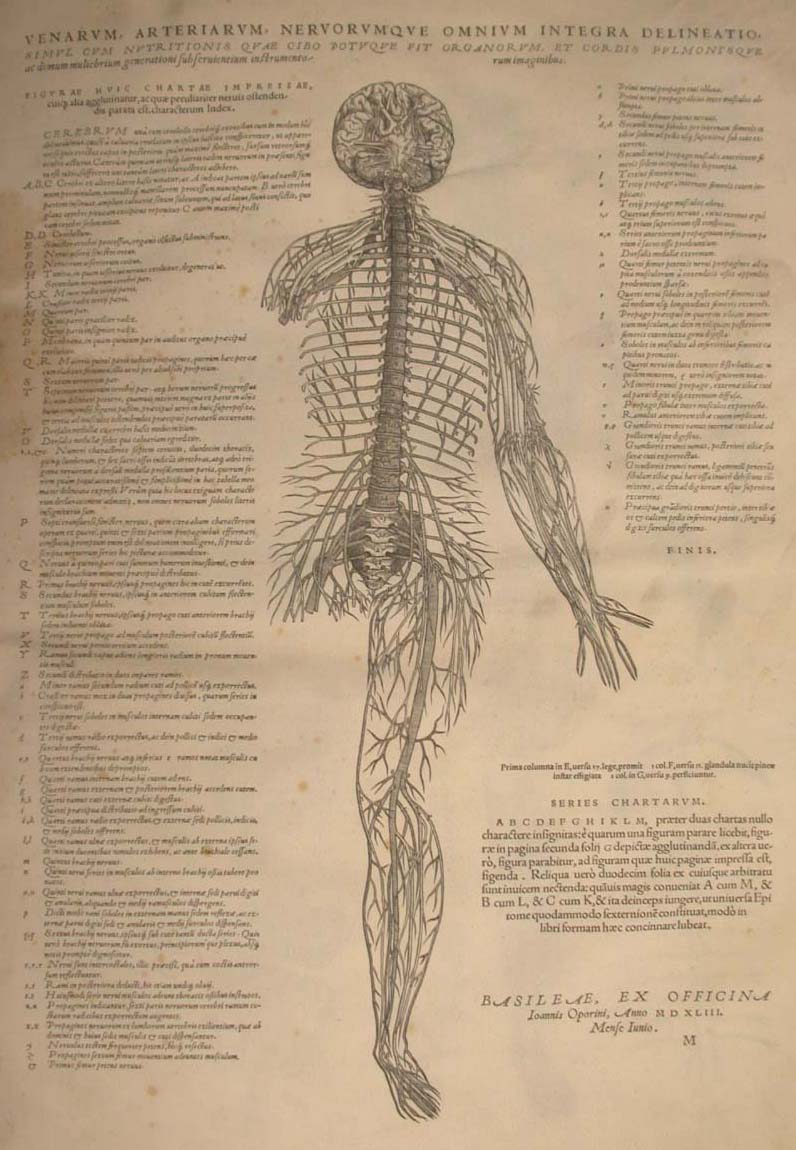 |
Image by Andreas Vesalius (1514-1564), contemporary of Copernicus, suggested (less than 500 years ago) that nervous system rather than heart was origin of behavior (see Milestones in Neuroscience Research for a time line extending from 4,000 B.C.). |  |
Image by Rene Descartes (1596-1650). Set framework for several centuries (and continuing) discussion: mind and body distinct things or same thing? |
| Nervous system is material object, part of body, can be touched, manipulated, measured. What IS the relationship between brain (nervous system) and behavior (broadly defined to include human experience)? Subset of this are questions such as the relation between mind and brain, mind and body, matter and spirit, matter and form ... | |||
The core of the challenge
- Emily Dickinson (1830-1886)
- Francis Crick, 1995: The Astonishing Hypothesis: "a person's mental activities are entirely due to the behavior of nerve cells ... and the atoms, ions, and molecules that make them up and influence them".
- V.S.Ramachandran, 2003: " it never ceases to amaze me that all the richness of our mental life - all our feelings, our emotions, our thoughts, our ambitions, our love life, our religious sentiments and even what each of us regards as his own intimate private self - is simply the activity of these little specks of jelly in your head, in your brain. There is nothing else"
- Paul Grobstein, contemporary: "Brain = behavior, there isn't anything else."
- Descartes (among others) was ... wrong? We are actually nothing more, and nothing less, than organized clumps of matter? From which it follows that ... ?
Brain = behavior?, from a "scientific" approach:
The Nature of Science
Science as Story Telling and Story Revision
(article, web resources, on-line forum)
Relevant both as context for course and as introduction to fundamental feature of brain, "loopiness"
| Linear science | Seriously loopy science |
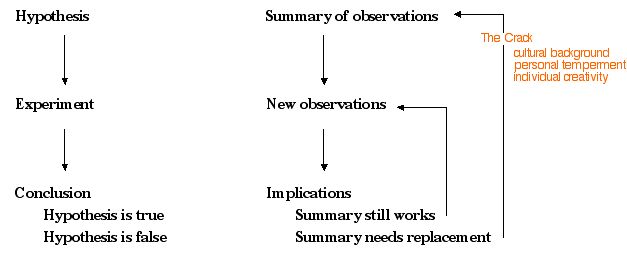 |
|
| Science as body of facts established by specialized fact-generating people and process
Science as successive approximations to Truth
|
Science as ongoing process of getting it less wrong, potentially usable by and contributed to by everyone
Science as ongoing making of observations, intepreting/summarizing, making new observations, making new summaries Science as process of inquiry into anything, one which everybody is equiped to do/can get better at/be further empowered by, and contribute to - a way of making sense of what is but even more of exploring what might yet be |
| If science is as much about creation as discovery then the "crack"is a feature, not a bug ... and differences among people are an asset to the process rather than a problem or an indication it isn't working |
Trying It Out
Which of the following two stories do you prefer?- The earth is flat (Flat Earth Society)
- The earth is round
Because of ...
- personal observations?
- observations made by others (personally verified or not)?
- social stories (heard from others)?
- usefulness?
Is one or the other story true? Have there been others? Are there others? Will there be?
Which of the following two stories do you prefer?
Because of ...
- personal observations?
- observations made by others (personally verified or not)?
- social stories (heard from others)?
- usefulness?
- is one or the other story "true"? are there others?
Is one or the other story true? Have their been others? Are there others? Will there be?
Scientific stories are frequently efforts to summarize the widest possible range of observations, always motivate new observations and hence new stories, should never be understood as "authoritative" or "believed in", do not compete with or invalidate other stories. Key issues about scientific stories
|
Which story do you prefer about brain and behavior?
| Descartes et al: There is brain and mind (or soul or ...) | 14 |
| Dickinson et al: Its all brain/neurons/matter ... | 15 |
| Unsure/fence-sitting/other |
8 |
Issue is not "Truth" but whether there is a good "summary of observations", "working hypothesis", something that contributes to getting it continually "less wrong" is useful for the ongoing generation of new stories in science and in culture at large ... Keep "loopiness" in mind, not only for science but also for the brain
Our task for the semester (and beyond?):
to try and make sense of an existing and continuing explosion ofobservations on the brain, observations that have the potential togreatly influence our sense of ourselves and our relation to the world.... and to help others make sense of it as well.
Your starting thoughts about "brain=behavior", about science as story? about loopiness? ... are they good summary of observations? stories? What observations do they not incorporate? What new questions do they raise?
27 January 2008
Starting thoughts, from the forum
Theidea of loopy science is appealing, it makes sense. A lot of science isalways changing. Even the most definitive of rules have exceptions.(F=ma included). The only problem is that the way the general public isto anticipate that anything that comes from a scientist has to be‘true’. Look at toothpaste ads, or dandruff shampoos – ‘70% ofresearchers say…’ or ’96% damage control, tested and proven’. It’s acultural thing. Now if the producers were to say that this is true onlyfor the cases tested, not many toothpastes will sell. What I am tryingto say is that while the idea of loopy science is definitely credible,it is an idea that will be hard to put across to all of the generalpopulace ... mmg
I too was only taught the linear way of exploring science and it was never too fun for me ... kjean
learning about this new way of thinking about science basically putinto words what I had been striving to do that whole year but was heldback from ... Brie Stark
The linear method we were all taught in grade schools I believe wasappropriate for use as a learning tool. Many of the labs throughoutgrade school were not there to make you think about the scientifictheory behind the lab topic, but to learn lab techniquesand prove something at that current time. Sure eveything changes overtime and something that might be true one day might not be true thenext, but at the same time there needs to be some results or therewould be no grants given to science. I believe there is a differencebetween the loopiness and the linear models, and they both serve theirown individual purpose with the loopy model building on the linearmodel ... jwiltsee
Beforecoming to college I had always believed that there was absolute truthin science. I was taught that it was a fact that an airplane could flyand that the sun rises and sets in the sky every morning and evening,and I felt no reason to challenge these beliefs because they wereconstantly reinforced by my real life experiences. I realize that mostpeople would find it ridiculous to spend a day, let alone a lifetime,trying to prove these “truths” incorrect. But there arescientists out there that spend their academic life trying to findcontradictory evidence to these long held beliefs, and their work hasand will continue to benefit us for years to come .... If there were absolute truth in science, science would eventually disappear ... bbaum
I do wonder how useful it is to eliminate the concept of truth. To whatdegree, I wonder, does human nature depend on truth and how do werespond to that need? Can humans feel trust without certainty? .... jlustick
Thinking about truth in science hasled me to think about truth in more philosophical terms. What is truthreally? Does truth even exist? If everything we know as reality comesfrom our brain and nervous system, how do we know what we perceive is actually reality and not out brain making things up? I don’t know, but thinking about things like this makes my head hurt ... Leah Bonnell
Once we establish and believe in the construction of the mind that is science, there can be definitive truth ... BeccaB-C
| Pro Descartes | Pro Dickinson |
|
I still lean toward Descarte's view because I just can't understand how a bunch of chemical interactions could create a person's inner being/consciousness/sense of self/whatever you want to call it ... Crystal Leonard I feel like the mind is just a lens through which we experience a real world. If not, how is it that each of our minds are constructing reality, but we are able to agree on what this reality is (like things we come into physical contact with)? In that sense, I guess I agree with Descartes that the mind is not something we construct ... bkim Matter would be nothing had the concept of it not been a construction of the mind, or would it?? ... kjean I think Descartes understanding of the nervous system makes the system most easily understood by the most number of people (assuming they are all rational), and because of this fact, it therefore seems 'more true' or 'less wrong' ... bpyenson With Dickinson’s view it seems as if we’re living in a fantasy world constructed by our brains, which is fascinating to think of when writing science fiction or philosophy but I would like to think that what I’m experiencing is real and not something my imagination came up with ... fquadri i think that saying everything is a construct of our own brains gives us a more important role in the world than we really have ... hope How can something like morality simply be a result of firing neurons? ... shikha |
It would be nice to think that the world is almost magical in that my brain is creating what it wants ...Aybala50 I think our brains are complex enough to create complex emotions and our "inner mind." ... Leah Bonnell Dickinson’s idea, in conjunction with neurobiological information, may lead to a narrower, but more thorough exploration and understanding of the relationship between mind and brain. If we accept neurons and neurotransmitters as the basic mechanisms responsible for brain function, can we use these well-supported observations as building blocks to eventually comprehend the mind-brain relationship? ... kenglander So if we look at Dickinson the “the brain = behavior” we can start to look for some answers in the physical mass that is our brain ... ilja Without knowing the brain completely, I don’t think we can say that the dualism is right (or wrong) because the entity--the brain-- we are dealing with is not fully graspable. So, I would rather lean toward Dickinson’s view because that opens more possibilities ... redmink |
Start with overview of the "trend of the evidence":
- Behavior can be altered by altering the nervous system
- Traumatic brain damage
- Surgery, drugs, and ... ?
- Epilepsy as an instance
- Lots of aspects have behavior, even quite sophisticated ones, have "material" feel about them
- Surprising and quite sophisticated things can emerge from interactions of simple elements (of which the brain/nervous system is an example, as we'll see).
- It isn't that anything "disappears" as one discovers things related to the brain but rather that the Brain gets "wider"
- Disadvantages?
- Advantages:
- ???
- would make the unobservable observable?
- Brain=behavior "True"? ("perhaps we just do not have the right microscopes yet"?). Good "story"?
- Are brains both sufficiently different and sufficiently similar to account for both differences and similarities in behavior?
- Do all things that influence behavior influence the brain?
- Is thinking a "physical" process? that can affect physical things?
- How do we distinguish between acting with and without thinking?
- Is morality/altrusim a function of the brain?
- Is "agency" a function of the brain?
- If everybody has their "own construct of what the world is" what follows from that?
- If the brain is itself a construction of the brain what follows from that?
- If brain = behavior, is all mystery lost? are there still "intriguing" things?
IF Emily et al are right:
- "brain"="nervous system"=body=matter, therefore all action/experience a function of organized matter? complexity from simplicity?
- Brains must not be only "reactive"
- Brains are to some degree different in different people
- Brains in given people must change with time/experience, must be affected by culture/language, nexus point for ALL influences on behavior?
- Brains must have different parts?
Some starting points: a sphagetti bowl? ("chains of neurons" or "hormones, chemicals")
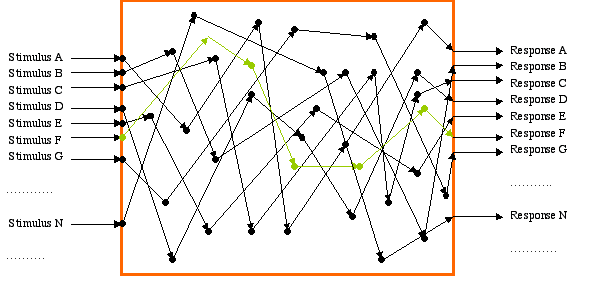 |
The sphaghetti (switchboard, "reflex") box model
Virtues
|
 |
Sphaghetti (switchboard, "reflex") plus box model
Virtues
|
A rethinking - boxes in boxes
 |
The sphaghetti (switchboard, "reflex") box model
Virtues
|
Facing up to the stereotopy, stimulus-response problem ... freeing the box from the outside world, adding autonomy
| Harvard Law of Animal Behavior
"Under carefully controlled experimental circumstances, an animal will behave as it damned well pleases"
|
The boxes inside boxes (with "autonomy") model
Virtues
|
If brain=behavior then the nervous system must not be astimulus/response machine (nor a bag of chemicals) that is invariantand the same in everyone. It must instead be a different kind of "machine"
- somewhat different in different individuals,
- affected by both genes and experiences/culture,
- capable of
- different outputs for the same input
- taking in inputs with no output
- generating outputs with no input
- a "semi-autonomous" input/output box consisting of input/output boxes.
Go on to look at actual nervous systems to see if they satisfy expectations and to address issues ... further iterations ("getting it less wrong") to come.
3 February
Issues for future consideration
Does our intelligence come from the presence ofthe “mind?” Do other, less intelligent creatures possess a mind, or dothey only have a brain? ... bbaum
My pony has a lot of what I would term, common sense ... jrlewis
if this experiment were done with a human we would not be able todistinguish the signals coming from the brain as anything but justsignals. Even if there was no body to communicate them would innerthinking still be going on? ... Sam Beebout
If the outside world is a construct of our mind, does this mean that aconstruct of the brain is controlling how the brain itself will act? It’s as ifthe brain as created a playground for itself, for which it can play in ... fquadri
we are in a a world where there is a box within a box within a box andthen some. Our culture can be considered the mother of boxes, with allmajor inputs bouncing into us from our culture, and our reactions areto react within that box. sometimes our outputs stay within the box ofthe culture, and sometimes it bounces out. That way, our culture endsup effecting other culture boxes - which explains why nowadays there isa rise of anorexia in the eastern culture. That makes sense, doesn't it? ... hamsterjacky
in this model of the nervous system, there is NO foundationalproperties, there are no real built-in valuation systems of saying anyaspects of the model are more important for its functioning than anyother components. Maybe input is as equally valid as output. Ifthat's the case, why can't we just switch the model on its head andmake outputs inputs and inputs outputs, and see if the model holds'true' then? .... bpyenson
Itoo (like others before) like this idea of loopy science as I do theidea of boxes within boxes as a representation for the nervous system.Both offer a way out/around the set ‘rules’ that science is perceivedto be .... wemight soon abandon the input/output box model as we discarded the onesbefore it and move onto a modification or a new one - one that has somesort of explanation for contextual factors for indviduals(culture,faith..), and also to keep the loopiness going ... mmg (see also kjean, ilja, drichard)
Immediate issues: boxes/outputs/inputs
It seems like the input/output box isfavored by majority of the class. However,for me, stimulus/response model is still fine. Although I agree that input/output sounds more neutral and they add morecomplexity, I don’t have strong conviction to favor the input/output model yet.I think it is because I had been a strong believer who’s convinced that thefunction of the brain and behavior are solely based on chemical activity.So, it is hard for me to abandon my oldbelief, the concept of stimulus/response ... redmink
I've always been fascinated by the internalvoice. What is it? How is it created? Obviously the internal voicedoesn't have a specific input that leads to its formation, so it'screated by one of the boxes within the box. But is the internal voicean output? ... Crystal Leonard
it seems to me that the essence of thought could really be compared to this box with no input signal ... Brie Stark (see also bkim)
It's not clear to me still how a box can produce output with no input, and vice versa ... Sarah Tabi (see also cc)
Now that we have a basic nervous system model as a reference I think we can confidently explore neurobiology and behavior ... Lisa B.
the boxes model still leaves open the possibility that there may be ametaphysical mind that operates outside of the physical. The boxesmodel has unexplained portions within the smaller boxes. How are inputsprocessed? What happens within the workings of the mind that createsand output, or not? ... eglaser
Even if you say all the way down, then what does the all the way downturtle stand on. What I'm trying to say is there must be a finitenumber of boxes that are within the larger boxes ... jwiltsee
how does this box model explain the recurrence of nightmares or imagesof traumatic experiences? How does the box model explain how weorganize inputs once we receive them, and how we control outputs? ... nafisam
Since I am currently at a loss for how to investigate these boxeswithin boxes, I wonder if it is possible to explore the arrows thatconnect these boxes. Do they represent the neurons in the brain? ... kenglander
The "real" nervous system - an input/output box consisting of interconnected input/output boxes?
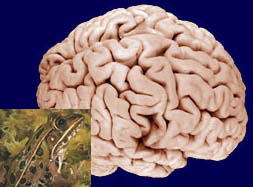 |
 |
| photo from Kemali and Braitenberg, Atlas of the Frog Brain, Springer-Verlag, 1969 |
Each box in turn (somewhat arbitrarily) subdividable into smaller boxes (with some differences among vertebrates, to return to)
And those ... yes, "its boxes all the way down"
The smallest box: neurons everywhere
Invertebrate nervous systems also have neurons, but differently arranged - makes sense?
Neuron as common, smallest box and as input/output element, connected to other boxes
- Cells, like other cells, but specialized to receive/process transmit "information" (as opposed to matter or energy)
- Size scale - tens of microns (10-6) meters)
- Larger boxes must differ in how smallest interconnected
- Relevance of numbers? enough to "account for all the uniqueness that exists among people"? ... 1012exp1012 possible nervous systems?
- Differences between people, differences between organisms due to .... not building blocks but assembly (architecture)
- Need to know how neurons work - to return to
Can use boxes->boxes ... ->boxes(neurons) to show that larger boxes interconnected, in relatively specific ways (anatomical specificity) and to rigorously specify "input" and "outputs" of largest box ... nervous system itself
- grey matter (soma, dendrites, pre-synaptic terminals, neuropil) vs white matter (bundles of axons, tracts)
- central vs peripheral nervous system (some ganglia, but largely axon bundles
- output elements of nervous system (motoneurons, plus) = neurons with axon terminating outside nervous system
- input elements of nervous system (sensory neurons, plus) = neurons with receiving surface (dendrites) outside of nervous system
- everything else = interneurons
- numbers/proportions: more reason to think of ns as "semi-autonomous"
So ... at least parts of our box within box model real ... and helps define "input" and "output" more rigorously
Implies: different regions on brain, different brains, different behaviors largely because of different assemblies of similar elements ("architecture")
The "real" nervous system - different if behavior different?
- Among different kinds of organisms?
- Among different individuals? within individuals over time?
- Notice that differences leave open the question of what causes differences (genes, experiences, activity, culture, etc)
- Implies that "information" can alter matter; not mysterious, "info" turns out to be perturbations of matter organization in neurons, can via metabolic processes influence organization/properties of neurons
10 February
From the forum
the brain is not a machine because we cannot always predict the outcome of a stimulus. But what about Psychology?... the whole point of my Experimental Methods and Statistics class is to design experiments and to critically examine data all in the ultimate goal of better understanding human behavior. I mean, isn't that what Psychology is about-- to understand and predict human behavior ... ? ... Anna Dela Cruz
I felt really great knowing that no one else had my brain. It made me think about this struggle for individuality that everyone has or certain people focus their entire lives on .... kjean
It would seem that since there are an almost infinite amount of combinations of neurons, which are each their own “computer”, that all humans would be vastly different, and any foundations, such as social norms, would not exist. Given the fact that they do exist, perhaps outside influences such as culture and social norms tend to even things out, and account for the similarities in behavior among specific groups of people .... nafisam
I do think that social and cultural influences or information shape the brains of groups of people. When people adapt a certain set of morals or certain way of thinking, they must also induce change in their neuron organization ... bkim
if the leach had been just freshly born when its nervous system had been removed, or if somehow a leach system was cloned and never put in a leach body would it still produce output? in more general terms, can a nervous system produce output in the complete absense of any previous input? If so, then what would be the purpose of learning other than to standardize the output of all of our brains? ... hope
could an individual alter the physical structure of his or her brain? ... ddl
Can you detect thoughts in the brain with an MRI? What is the physiology of a thought? ... eglaser
maybe thinking involves different parts of the brain, like the frontal lobe and temporal lobe, interacting with each other .... leah bonnell
At what point within the spaghetti web of interneurons does information go from unconscious to cortexual and conscious? - BeccaB-C
Our NS seems to be very complex and if it is responsible for our behavior, or can explain our behavior I think that maybe we have to look at some of the bigger boxes first ... ilja
The "real" nervous system - different if behavior different?
- Among different kinds of organisms?
- Among different individuals? within individuals over time?
- Notice that differences leave open the question of what causes differences (genes, experiences, activity, culture, etc)
- Implies that "information" can alter matter; not mysterious, "info" turns out to be perturbations of matter organization in neurons, can via metabolic processes influence organization/properties of neurons
Outputs - topographic organization - anatomical specificity
- Motoneurons located at levels of neuraxis related to location of muscles controlled
- Each motoneuron activates only one muscle
- Implications:
- "action" is not one output but pattern of activity across lots of them - "motor symphony"
- source of lots of additional variation in behavior
- lots of outputs/nervous system involved in any "action", is "distributed" characteristic
- need to understand how patterns of activity created, parts coordinated
- Sensory neurons terminate at levels of neuraxis related to location of receptors
- Implications
- "sensation"/"perception" not one input but pattern of activity across lots of them (across modalities and, as will be seen, in one modality - another "distributed" characteristic
- need to understand how inputs combined
- thought = pattern of activity across lots of neurons
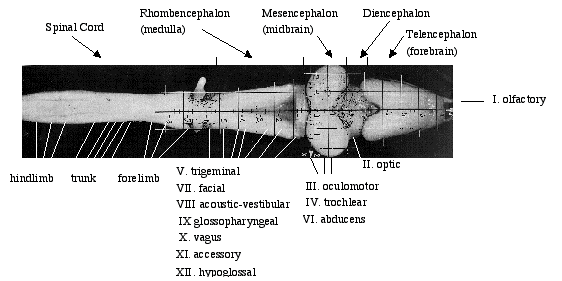 |
For additional information: |
Usefulness of the interconnected box model and ... another box?
- Capabilities of spinal cord
- Quadriplegia (slightly better) - relevance of topographic organization
- Christopher Reeves and ... , from NIH
- The "I-function"
Observations "surprising", but have to be accepted - Issue is "how to make sense of them"
Two kinds of behavior ("reflex" versus something-else) intuition probably not useful
- Spinal cord capable of very sophisticated activity
- Brain capable of quite unsophisticated activity
- Distinction between "reflex" and other things?
- "foot withdraws when irritated" - spinal cord capable of sophisticated activity on own
- is ok ... given topography and "physical contiguity principle ("PCP")
- "person doesn't say ouch when foot irritated" - behavior frequently depends on linking paths within nervous system
- is ok ... given topography and "physical contiguity principle ("PCP")
- "person doesn't move foot when hearing (or reading) request to do so" - behavior frequently depends on linking paths within nervous system
- is ok ... given topography and "physical contiguity principle ("PCP")
- "person says foot irritation not felt/experienced" - behavior frequently depends on linking paths within nervous system
- is ok ... given topography and "physical contiguity principle ("PCP") AND ..
- "behavior" can occur without it being experienced by the behaving organism AND ...
- neuronal circuitry adequate to support "feeling/experiencing" (I-function) is in the brain (spinal cord not needed for this function)
- Where is Christopher Reeves? Is he paralyzed? Does he feel pain? - has to do with "mind", "self", "soul", "personality", "consciousness" ?
- words requiring redefinition in light of new experiences/observations?
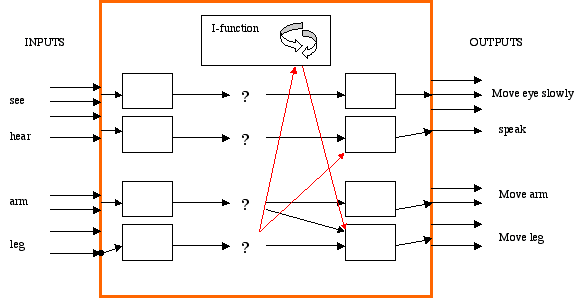 |
Ascending somatosensory pathways Descending motor pathways
|
If its all sensory neurons, motoneurons, interneurons, and signalsmoving among them (the I-function included), we need to look at signals, what they are, howthey're handled ...
Signals:
- Resting potential
- Action potential
- Receptor and generator potentials
- Synaptic potentials
17 February
From the Forum
The fact that the parts of your body correspond to a certain section of the nervous system in an corresponding and relative manner never occurred to me. Nor did I pay much attention when I walked, talked, sat and stood about just how my body was accomplishing these requests ... SandraGandarez
thinking about an action and performing an action are different. Thoughts can be completely dissociated from inputs and outputs in the nervous system ... jrlewis
Could it be that autism is an anomaly, like the Reeves anomaly, of the I-function where somehow, some cords got tangled/cut/rearranged ... Brie Stark
I asked whether or not the "I-Function" is something used among neurobiologists or if the term/concept is just for the convenience of the class. I think it is important to understand where our class conversations intersect with the larger conversations that neurobiologists are having (see also Lisa B) ... We discussed the fact that the I-function is related to, but not the same as, the conscious/unconscious distinction, but I'm interested in learning more about where these two concepts overlap. In other words, if dreams are part of the unconscious, can they also be part of the I-function? ... jlustick
"I" am the focus of my actions, my actions are focused around me. Other people's perceptions of my personality is based on a series of actions that "I" am responsible for ... Sarah Tabi
it seems like the I-function is what we consider "self" ... Leah Bonnell
Which part of our body is truly essential to our individuality? And also, is there such a part? ... ilja
In order to reach a high level of competition, one must make the right action at precisely the right time. In a fast paced sport, such as fencing, these decisions are made in a matter of seconds.But at what point does the “I function” end, and muscle memory begin? ... Adam Zakheim
It was interesting to hear about the concept of pain being explained as a simple pattern of activity in one of the boxes of our nervous system. In our diagram of the system I would have thought it to be an input. After all, a person can percive pain without using their I-function. when a person burns their hand they withdraw the hand at the first feeling of pain, before the brain has time to register it. Does pain only be labeled pain if it is a part of the I-function? ... eglaser
maybe consciousness is simply being able to take in all the input signals from the environment and being able to potentially react to them. While the I-function is a part of consciousness--the part that focuses on thinking about how the "I" is going to interact with the environment. Perhaps the "I-function" fits under the larger umbrella term of "consciousness" ... bkim
for something as abstract and complicated as the I-function (a person's character, individuality, decision making), can just physical interactions between nuerons be held accountable? I find it hard to get my head around this divide ... mmg
The thing I'm still unsure about was in class we spoke about babies being different at birth and then converging to become similar in society. I think this is completely opposite. I believe that babies are very similar at birth, because they have no yet had the influence of society. I believe as individuals grow they diverge from one another, maybe not totally, but they diverge because of nurturing, society, morals, culture, and them just wanting to be different. This can swing back to the I function, where your individual self will make decisions and your mind will see things as it wants to construct them ... jwiltsee
For every unthinking action, is there also an identical set of neurons which allow that action to be regulated or produced within the constraints of the 'I' function box? Or is the 'I' function essentially able to tap into and oversee every other box within the human body ... ddl
If we were able to move the boxes required for walking lower in the nervous system, our brains may be able to accomplish more complex tasks because there is more room and energy for these tasks ... bbaum
Start with action potential,use it to raise questions that will lead to explanation of restingpotential, use those ideas in turn to successively build up a set ofmore basic ideas that collectively account for all signalling.
- continual motion (diffusion)
- concentration gradients of charged particles (ions)
- specific membrane permeability
- passive current flow
- variable membrane permeability
Action potential - longitudinal battery which appears/disappears successively at successive points along an axon ("travels" at finite speed), "all or nothing" transient (millisecond range) event
- Helps to account for "thinking takes time"
- Is the common currency of "information" in nervous system cables (axons, axon bundles), of all organisms
- Problem: how distinguish action from perception from thought?
- Solution: anatomical specificity ("see thunder, hear lightning")
- Is way to "see" otherwise unobservable
- Need to understand it - doing so will help make sense of other potentials, provide further insights into how ns COULD be behavior
To understand action potential, need first to understand resting potential - transverse battery, continuously present, with potential for continuous variation
| Organization based on random motion |
- Diffusion
- Selective permeability
- Charged particle movement, balance of diffusion and battery creation
- Stable transverse battery, with potential for variation
- Concentration gradients, energy dependent ion pumping
- Can get action potential? what more?
24 February
The I-function
It now makes more sense to me why thinkinng sometimes makes me unable to do things. I'd always noticed that i couldn't do certain things, like driving or playing sports, if i thought about what i was doing, but i'd never thought about the reason. Maybe it is simply that thinking, or sending signals around in the "I-function", takes time, and when there isn't a lot of time the signals have to be sent directly to the muscles and skip the i-function ... hope
Now it makes more sense why I wasn't getting better, but worse for a while. Until I got used to the new routine, I was thinking about every step and because it wasn't more instinctual I wasn't playing as well. When I got a hang out the new moves, I started playing a lot better ... aybala50
I disagree that use of the I-Function impedes the execution of an act ... Olufemi.Nazsira
Action potentials: issues to keep in mind
Why is it that brain activity is so often portrayed as an electrical current when it is in fact a chemical one? It is interesting to note the inherent misconceptions about the brain that we must address. No electricity in the brain ... so how else has so called 'common knowledge' tricked us? ... eglaser
Do these chemicals and electric currents give rise to our thoughts and self-awareness as well? ... bkim
Is it just Sodium and Potassium that accounts for some of the best literature or art that is in the world today? ... mmg
It has often benefited me to look at the nervous system (and many other body systems) as a symphony of sorts. If all the individual instruments (the chemicals and proteins) play well, the body's song as a whole will be pleasing ... drichard
it is revealed that the girl has a rare genetic disorder which causes her to be insensitive to pain. Due to this insensitivity, the girl believed that she was a superheroine and often dared classmates to injury her ... Anna Dela Cruz
How much of this is in the hands of him/her? How much of experiencing pain is mental and how much is behavioral? ... BMCsoccer01
reaction time connects to the exercise we did in class where we proved through a computer program that it takes time to think. If thinking involves neurons, then it must also involve action potentials, which take time to travel ... Leah Bonnell
Whenever I've been close to stepping on something painful or running into something, I've always noticed the little delay before my body reacts to what I'm seeing. Instead of knowing that propagation is occurring and that all of these reactions are attempting to get me out of harm's way, I've always just thought that it was the surprise that caused my hesitation ... SandraGandarez
Issues to deal with more immediately
what would be the effect of two oppositely oriented action potentials moving into one another? ... ddl
Can action potentials move faster or slower? ... jlustick
Thinking of an action potential in this way can perhaps help explain how some input can have no output. If the cell membrane is not depolarized enough (ie it does not reach the threshold potential) an action potential will not be generated, it thus the input may not have an output ... shika (see also jwiltsee re pain)
We mentioned before that not all output boxes are connected to input boxes. Does that mean action potentials can be generated without stimuli? ... Sarah Tabi
Propagation
Notice it is NOT matter moving, nor energy, it is a perturbation (signal, information) |
Will propagate if started. How affect things? How started? Need tounderstand synaptic potentials, receptor potentials, but first ...
Lots of things can start it. Among them is something that provides answer to one of our box questions ...
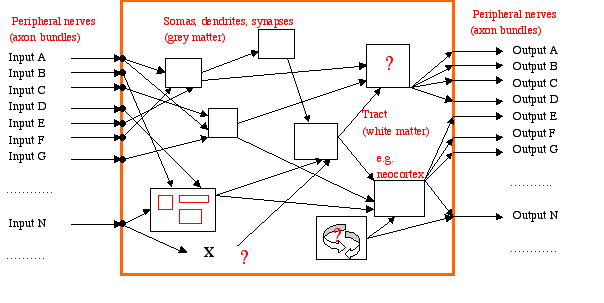
And the big question ... Do signals actually start in the middle of the box? If so, how?
Yes, not mysterious, follows from what we know,if we add possibility of some differences in permeability of somemembrane regions not mysterious, has interesting implications ...
- brain in a vat
- action without "personal responsibility"?
- epilepsy
- other things?
Go on to receptor potentials, synaptic potentials (how actionpotentials affect things, how boxes integrate, how signals stopped inbox)
Input (sensory) signals - an example
- Neuronal receiving surface outside nervous system
- Sensory transduction - specific channels varying permeability in response to external events
- Receptor potential - continuously variable in space/time (like passive current flow
- Transformed into action potentials
- Coding in pattern of action potentials
- Significance for behavior?
- Restricted sample of "reality"
- All representations of "reality" in same form, in same signals as those created in nervous system itself
- Anatomical specificity IMPORTANT ("hear lightning, see thunder")
- Extra-sensory perception
- "five senses"?
- proprioception (muscle spindles, tendon organs, plus)
- pheromones
- others?
Synaptic potentials - Synaptic integration
- action potential vanishes at synapse
- intermediate chemical step: neurotransmitter release and ... (multiple control steps)
- permeability change leads to synaptic potential (alternate), also continuously variable in space/time
- summation - neuron as integrator rather than relay
- inhibitory synaptic potentials, algebraic summation
- is how to "stop" signals - significance for behavior?
20 January
The challenge in detail, and in general
- Can Eye Color Have An Effect on Vision?, NYTimes, 19 Jan 2009
- Trying Everything and Anything for Autism, NY Times, 19 Jan 2009
- Purple Heart is Ruled Out for Traumatic Stress, NY Times 7 Jan 2009
- Psychiatrists Revise the Book of Human Troubles, NYTimes, 17 Dec, 2008
- Study Finds Drug Risks with Newer Antipsychotics, NYTimes 14 Jan 2009
- A Problem of the Brain, Not the Hands: Group Urges Phone Ban for Drivers, 12 Jan 2009
- A Love Vaccine, 12 Jan 2009
- Sex and Depression: In the Brain if not the Mind, NYTimes 19 Jan 2009
- My Genome, My Self, NYTimes, 11 Jan 09 (see also The Self: Genes, Environment, Chance, and ... Free Will?
"The more scientists look, the more they're able to tease romance apart into its individual strands--the visual, auditory, olfactory, tactile, neurochemical processes that make it possible."
Jeffrey Kluger, "Why We Love", Time Magazine, 17 January, 2008
"Moral intuitions ... are being explained with tools from game theory, neuroscience, and evolutionary biology"Steven Pinker, "The Moral Instinct", NYTimes Magazine, 13 January 2008
"if time doesn't exist, why do we experience it so relentlessly? Is it all an illusion?"The response in general
Assemble a team of people with different backgrounds/perspectives tolook into what is emerging from scientific exploration, become familiarwith it and its implications, become involved directly and/or byhelping others understand/become involved
Who are we? (your intros on course home page)- What distinctive experiences/characteristics do you bring to the conversation this semester?
- List three questions that you'd like to see explored during the semester
The challenge more concretely
Neurobiology and BEHAVIOR ... what is "behavior"?
| Everything we can observe another organism/person doing from outside them, together with everthing we think we need to imagine going on inside them to account for what we observe from outside (emotions, drives, creativity, consciousness, agency, rationality, self?) |
NEUROBIOLOGY and behavior ... Neurobiology = study of the nervous system ... what is the "nervous system"?
 |
Image by Andreas Vesalius (1514-1564), contemporary of Copernicus, suggested (less than 500 years ago) that nervous system rather than heart was origin of behavior (see Milestones in Neuroscience Research for a time line extending from 4,000 B.C.). |  |
Image by Rene Descartes (1596-1650). Set framework for several centuries (and continuing) discussion: mind and body distinct things or same thing? |
| Nervous system is material object, part of body, can be touched, manipulated, measured. What IS the relationship between brain (nervous system) and behavior (broadly defined to include human experience)? Subset of this are questions such as the relation between mind and brain, mind and body, matter and spirit, matter and form ... | |||
The core of the challenge
- Emily Dickinson (1830-1886)
- Francis Crick, 1995: The Astonishing Hypothesis: "a person's mental activities are entirely due to the behavior of nerve cells ... and the atoms, ions, and molecules that make them up and influence them".
- V.S.Ramachandran, 2003: " it never ceases to amaze me that all the richness of our mental life - all our feelings, our emotions, our thoughts, our ambitions, our love life, our religious sentiments and even what each of us regards as his own intimate private self - is simply the activity of these little specks of jelly in your head, in your brain. There is nothing else"
- Paul Grobstein, contemporary: "Brain = behavior, there isn't anything else."
- Descartes (among others) was ... wrong? We are actually nothing more, and nothing less, than organized clumps of matter? From which it follows that ... ?
Brain = behavior?, from a "scientific" approach:
The Nature of Science
Science as Story Telling and Story Revision
(article, web resources, on-line forum)
Relevant both as context for course and as introduction to fundamental feature of brain, "loopiness"
| Linear science | Seriously loopy science |
 |
|
| Science as body of facts established by specialized fact-generating people and process
Science as successive approximations to Truth
|
Science as ongoing process of getting it less wrong, potentially usable by and contributed to by everyone
Science as ongoing making of observations, intepreting/summarizing, making new observations, making new summaries Science as process of inquiry into anything, one which everybody is equiped to do/can get better at/be further empowered by, and contribute to - a way of making sense of what is but even more of exploring what might yet be |
| If science is as much about creation as discovery then the "crack"is a feature, not a bug ... and differences among people are an asset to the process rather than a problem or an indication it isn't working |
Trying It Out
Which of the following two stories do you prefer?- The earth is flat (Flat Earth Society)
- The earth is round
Because of ...
- personal observations?
- observations made by others (personally verified or not)?
- social stories (heard from others)?
- usefulness?
Is one or the other story true? Have there been others? Are there others? Will there be?
Which of the following two stories do you prefer?
Because of ...
- personal observations?
- observations made by others (personally verified or not)?
- social stories (heard from others)?
- usefulness?
- is one or the other story "true"? are there others?
Is one or the other story true? Have their been others? Are there others? Will there be?
Scientific stories are frequently efforts to summarize the widest possible range of observations, always motivate new observations and hence new stories, should never be understood as "authoritative" or "believed in", do not compete with or invalidate other stories. Key issues about scientific stories
|
Which story do you prefer about brain and behavior?
| Descartes et al: There is brain and mind (or soul or ...) | 14 |
| Dickinson et al: Its all brain/neurons/matter ... | 15 |
| Unsure/fence-sitting/other |
8 |
Issue is not "Truth" but whether there is a good "summary of observations", "working hypothesis", something that contributes to getting it continually "less wrong" is useful for the ongoing generation of new stories in science and in culture at large ... Keep "loopiness" in mind, not only for science but also for the brain
Our task for the semester (and beyond?):
to try and make sense of an existing and continuing explosion ofobservations on the brain, observations that have the potential togreatly influence our sense of ourselves and our relation to the world.... and to help others make sense of it as well.
Your starting thoughts about "brain=behavior", about science as story? about loopiness? ... are they good summary of observations? stories? What observations do they not incorporate? What new questions do they raise?
27 January 2008
Starting thoughts, from the forum
Theidea of loopy science is appealing, it makes sense. A lot of science isalways changing. Even the most definitive of rules have exceptions.(F=ma included). The only problem is that the way the general public isto anticipate that anything that comes from a scientist has to be‘true’. Look at toothpaste ads, or dandruff shampoos – ‘70% ofresearchers say…’ or ’96% damage control, tested and proven’. It’s acultural thing. Now if the producers were to say that this is true onlyfor the cases tested, not many toothpastes will sell. What I am tryingto say is that while the idea of loopy science is definitely credible,it is an idea that will be hard to put across to all of the generalpopulace ... mmg
I too was only taught the linear way of exploring science and it was never too fun for me ... kjean
learning about this new way of thinking about science basically putinto words what I had been striving to do that whole year but was heldback from ... Brie Stark
The linear method we were all taught in grade schools I believe wasappropriate for use as a learning tool. Many of the labs throughoutgrade school were not there to make you think about the scientifictheory behind the lab topic, but to learn lab techniquesand prove something at that current time. Sure eveything changes overtime and something that might be true one day might not be true thenext, but at the same time there needs to be some results or therewould be no grants given to science. I believe there is a differencebetween the loopiness and the linear models, and they both serve theirown individual purpose with the loopy model building on the linearmodel ... jwiltsee
Beforecoming to college I had always believed that there was absolute truthin science. I was taught that it was a fact that an airplane could flyand that the sun rises and sets in the sky every morning and evening,and I felt no reason to challenge these beliefs because they wereconstantly reinforced by my real life experiences. I realize that mostpeople would find it ridiculous to spend a day, let alone a lifetime,trying to prove these “truths” incorrect. But there arescientists out there that spend their academic life trying to findcontradictory evidence to these long held beliefs, and their work hasand will continue to benefit us for years to come .... If there were absolute truth in science, science would eventually disappear ... bbaum
I do wonder how useful it is to eliminate the concept of truth. To whatdegree, I wonder, does human nature depend on truth and how do werespond to that need? Can humans feel trust without certainty? .... jlustick
Thinking about truth in science hasled me to think about truth in more philosophical terms. What is truthreally? Does truth even exist? If everything we know as reality comesfrom our brain and nervous system, how do we know what we perceive is actually reality and not out brain making things up? I don’t know, but thinking about things like this makes my head hurt ... Leah Bonnell
Once we establish and believe in the construction of the mind that is science, there can be definitive truth ... BeccaB-C
| Pro Descartes | Pro Dickinson |
|
I still lean toward Descarte's view because I just can't understand how a bunch of chemical interactions could create a person's inner being/consciousness/sense of self/whatever you want to call it ... Crystal Leonard I feel like the mind is just a lens through which we experience a real world. If not, how is it that each of our minds are constructing reality, but we are able to agree on what this reality is (like things we come into physical contact with)? In that sense, I guess I agree with Descartes that the mind is not something we construct ... bkim Matter would be nothing had the concept of it not been a construction of the mind, or would it?? ... kjean I think Descartes understanding of the nervous system makes the system most easily understood by the most number of people (assuming they are all rational), and because of this fact, it therefore seems 'more true' or 'less wrong' ... bpyenson With Dickinson’s view it seems as if we’re living in a fantasy world constructed by our brains, which is fascinating to think of when writing science fiction or philosophy but I would like to think that what I’m experiencing is real and not something my imagination came up with ... fquadri i think that saying everything is a construct of our own brains gives us a more important role in the world than we really have ... hope How can something like morality simply be a result of firing neurons? ... shikha |
It would be nice to think that the world is almost magical in that my brain is creating what it wants ...Aybala50 I think our brains are complex enough to create complex emotions and our "inner mind." ... Leah Bonnell Dickinson’s idea, in conjunction with neurobiological information, may lead to a narrower, but more thorough exploration and understanding of the relationship between mind and brain. If we accept neurons and neurotransmitters as the basic mechanisms responsible for brain function, can we use these well-supported observations as building blocks to eventually comprehend the mind-brain relationship? ... kenglander So if we look at Dickinson the “the brain = behavior” we can start to look for some answers in the physical mass that is our brain ... ilja Without knowing the brain completely, I don’t think we can say that the dualism is right (or wrong) because the entity--the brain-- we are dealing with is not fully graspable. So, I would rather lean toward Dickinson’s view because that opens more possibilities ... redmink |
Start with overview of the "trend of the evidence":
- Behavior can be altered by altering the nervous system
- Traumatic brain damage
- Surgery, drugs, and ... ?
- Epilepsy as an instance
- Lots of aspects have behavior, even quite sophisticated ones, have "material" feel about them
- Surprising and quite sophisticated things can emerge from interactions of simple elements (of which the brain/nervous system is an example, as we'll see).
- It isn't that anything "disappears" as one discovers things related to the brain but rather that the Brain gets "wider"
- Disadvantages?
- Advantages:
- ???
- would make the unobservable observable?
- Brain=behavior "True"? ("perhaps we just do not have the right microscopes yet"?). Good "story"?
- Are brains both sufficiently different and sufficiently similar to account for both differences and similarities in behavior?
- Do all things that influence behavior influence the brain?
- Is thinking a "physical" process? that can affect physical things?
- How do we distinguish between acting with and without thinking?
- Is morality/altrusim a function of the brain?
- Is "agency" a function of the brain?
- If everybody has their "own construct of what the world is" what follows from that?
- If the brain is itself a construction of the brain what follows from that?
- If brain = behavior, is all mystery lost? are there still "intriguing" things?
IF Emily et al are right:
- "brain"="nervous system"=body=matter, therefore all action/experience a function of organized matter? complexity from simplicity?
- Brains must not be only "reactive"
- Brains are to some degree different in different people
- Brains in given people must change with time/experience, must be affected by culture/language, nexus point for ALL influences on behavior?
- Brains must have different parts?
Some starting points: a sphagetti bowl? ("chains of neurons" or "hormones, chemicals")
 |
The sphaghetti (switchboard, "reflex") box model
Virtues
|
 |
Sphaghetti (switchboard, "reflex") plus box model
Virtues
|
A rethinking - boxes in boxes
 |
The sphaghetti (switchboard, "reflex") box model
Virtues
|
Facing up to the stereotopy, stimulus-response problem ... freeing the box from the outside world, adding autonomy
| Harvard Law of Animal Behavior
"Under carefully controlled experimental circumstances, an animal will behave as it damned well pleases"
|
The boxes inside boxes (with "autonomy") model
Virtues
|
If brain=behavior then the nervous system must not be astimulus/response machine (nor a bag of chemicals) that is invariantand the same in everyone. It must instead be a different kind of "machine"
- somewhat different in different individuals,
- affected by both genes and experiences/culture,
- capable of
- different outputs for the same input
- taking in inputs with no output
- generating outputs with no input
- a "semi-autonomous" input/output box consisting of input/output boxes.
Go on to look at actual nervous systems to see if they satisfy expectations and to address issues ... further iterations ("getting it less wrong") to come.
3 February
Issues for future consideration
Does our intelligence come from the presence ofthe “mind?” Do other, less intelligent creatures possess a mind, or dothey only have a brain? ... bbaum
My pony has a lot of what I would term, common sense ... jrlewis
if this experiment were done with a human we would not be able todistinguish the signals coming from the brain as anything but justsignals. Even if there was no body to communicate them would innerthinking still be going on? ... Sam Beebout
If the outside world is a construct of our mind, does this mean that aconstruct of the brain is controlling how the brain itself will act? It’s as ifthe brain as created a playground for itself, for which it can play in ... fquadri
we are in a a world where there is a box within a box within a box andthen some. Our culture can be considered the mother of boxes, with allmajor inputs bouncing into us from our culture, and our reactions areto react within that box. sometimes our outputs stay within the box ofthe culture, and sometimes it bounces out. That way, our culture endsup effecting other culture boxes - which explains why nowadays there isa rise of anorexia in the eastern culture. That makes sense, doesn't it? ... hamsterjacky
in this model of the nervous system, there is NO foundationalproperties, there are no real built-in valuation systems of saying anyaspects of the model are more important for its functioning than anyother components. Maybe input is as equally valid as output. Ifthat's the case, why can't we just switch the model on its head andmake outputs inputs and inputs outputs, and see if the model holds'true' then? .... bpyenson
Itoo (like others before) like this idea of loopy science as I do theidea of boxes within boxes as a representation for the nervous system.Both offer a way out/around the set ‘rules’ that science is perceivedto be .... wemight soon abandon the input/output box model as we discarded the onesbefore it and move onto a modification or a new one - one that has somesort of explanation for contextual factors for indviduals(culture,faith..), and also to keep the loopiness going ... mmg (see also kjean, ilja, drichard)
Immediate issues: boxes/outputs/inputs
It seems like the input/output box isfavored by majority of the class. However,for me, stimulus/response model is still fine. Although I agree that input/output sounds more neutral and they add morecomplexity, I don’t have strong conviction to favor the input/output model yet.I think it is because I had been a strong believer who’s convinced that thefunction of the brain and behavior are solely based on chemical activity.So, it is hard for me to abandon my oldbelief, the concept of stimulus/response ... redmink
I've always been fascinated by the internalvoice. What is it? How is it created? Obviously the internal voicedoesn't have a specific input that leads to its formation, so it'screated by one of the boxes within the box. But is the internal voicean output? ... Crystal Leonard
it seems to me that the essence of thought could really be compared to this box with no input signal ... Brie Stark (see also bkim)
It's not clear to me still how a box can produce output with no input, and vice versa ... Sarah Tabi (see also cc)
Now that we have a basic nervous system model as a reference I think we can confidently explore neurobiology and behavior ... Lisa B.
the boxes model still leaves open the possibility that there may be ametaphysical mind that operates outside of the physical. The boxesmodel has unexplained portions within the smaller boxes. How are inputsprocessed? What happens within the workings of the mind that createsand output, or not? ... eglaser
Even if you say all the way down, then what does the all the way downturtle stand on. What I'm trying to say is there must be a finitenumber of boxes that are within the larger boxes ... jwiltsee
how does this box model explain the recurrence of nightmares or imagesof traumatic experiences? How does the box model explain how weorganize inputs once we receive them, and how we control outputs? ... nafisam
Since I am currently at a loss for how to investigate these boxeswithin boxes, I wonder if it is possible to explore the arrows thatconnect these boxes. Do they represent the neurons in the brain? ... kenglander
The "real" nervous system - an input/output box consisting of interconnected input/output boxes?
 |
 |
| photo from Kemali and Braitenberg, Atlas of the Frog Brain, Springer-Verlag, 1969 |
Each box in turn (somewhat arbitrarily) subdividable into smaller boxes (with some differences among vertebrates, to return to)
And those ... yes, "its boxes all the way down"
The smallest box: neurons everywhere
Invertebrate nervous systems also have neurons, but differently arranged - makes sense?
Neuron as common, smallest box and as input/output element, connected to other boxes
- Cells, like other cells, but specialized to receive/process transmit "information" (as opposed to matter or energy)
- Size scale - tens of microns (10-6) meters)
- Larger boxes must differ in how smallest interconnected
- Relevance of numbers? enough to "account for all the uniqueness that exists among people"? ... 1012exp1012 possible nervous systems?
- Differences between people, differences between organisms due to .... not building blocks but assembly (architecture)
- Need to know how neurons work - to return to
Can use boxes->boxes ... ->boxes(neurons) to show that larger boxes interconnected, in relatively specific ways (anatomical specificity) and to rigorously specify "input" and "outputs" of largest box ... nervous system itself
- grey matter (soma, dendrites, pre-synaptic terminals, neuropil) vs white matter (bundles of axons, tracts)
- central vs peripheral nervous system (some ganglia, but largely axon bundles
- output elements of nervous system (motoneurons, plus) = neurons with axon terminating outside nervous system
- input elements of nervous system (sensory neurons, plus) = neurons with receiving surface (dendrites) outside of nervous system
- everything else = interneurons
- numbers/proportions: more reason to think of ns as "semi-autonomous"
So ... at least parts of our box within box model real ... and helps define "input" and "output" more rigorously
Implies: different regions on brain, different brains, different behaviors largely because of different assemblies of similar elements ("architecture")
The "real" nervous system - different if behavior different?
- Among different kinds of organisms?
- Among different individuals? within individuals over time?
- Notice that differences leave open the question of what causes differences (genes, experiences, activity, culture, etc)
- Implies that "information" can alter matter; not mysterious, "info" turns out to be perturbations of matter organization in neurons, can via metabolic processes influence organization/properties of neurons
10 February
From the forum
the brain is not a machine because we cannot always predict the outcome of a stimulus. But what about Psychology?... the whole point of my Experimental Methods and Statistics class is to design experiments and to critically examine data all in the ultimate goal of better understanding human behavior. I mean, isn't that what Psychology is about-- to understand and predict human behavior ... ? ... Anna Dela Cruz
I felt really great knowing that no one else had my brain. It made me think about this struggle for individuality that everyone has or certain people focus their entire lives on .... kjean
It would seem that since there are an almost infinite amount of combinations of neurons, which are each their own “computer”, that all humans would be vastly different, and any foundations, such as social norms, would not exist. Given the fact that they do exist, perhaps outside influences such as culture and social norms tend to even things out, and account for the similarities in behavior among specific groups of people .... nafisam
I do think that social and cultural influences or information shape the brains of groups of people. When people adapt a certain set of morals or certain way of thinking, they must also induce change in their neuron organization ... bkim
if the leach had been just freshly born when its nervous system had been removed, or if somehow a leach system was cloned and never put in a leach body would it still produce output? in more general terms, can a nervous system produce output in the complete absense of any previous input? If so, then what would be the purpose of learning other than to standardize the output of all of our brains? ... hope
could an individual alter the physical structure of his or her brain? ... ddl
Can you detect thoughts in the brain with an MRI? What is the physiology of a thought? ... eglaser
maybe thinking involves different parts of the brain, like the frontal lobe and temporal lobe, interacting with each other .... leah bonnell
At what point within the spaghetti web of interneurons does information go from unconscious to cortexual and conscious? - BeccaB-C
Our NS seems to be very complex and if it is responsible for our behavior, or can explain our behavior I think that maybe we have to look at some of the bigger boxes first ... ilja
The "real" nervous system - different if behavior different?
- Among different kinds of organisms?
- Among different individuals? within individuals over time?
- Notice that differences leave open the question of what causes differences (genes, experiences, activity, culture, etc)
- Implies that "information" can alter matter; not mysterious, "info" turns out to be perturbations of matter organization in neurons, can via metabolic processes influence organization/properties of neurons
Outputs - topographic organization - anatomical specificity
- Motoneurons located at levels of neuraxis related to location of muscles controlled
- Each motoneuron activates only one muscle
- Implications:
- "action" is not one output but pattern of activity across lots of them - "motor symphony"
- source of lots of additional variation in behavior
- lots of outputs/nervous system involved in any "action", is "distributed" characteristic
- need to understand how patterns of activity created, parts coordinated
- Sensory neurons terminate at levels of neuraxis related to location of receptors
- Implications
- "sensation"/"perception" not one input but pattern of activity across lots of them (across modalities and, as will be seen, in one modality - another "distributed" characteristic
- need to understand how inputs combined
- thought = pattern of activity across lots of neurons
 |
For additional information: |
Usefulness of the interconnected box model and ... another box?
- Capabilities of spinal cord
- Quadriplegia (slightly better) - relevance of topographic organization
- Christopher Reeves and ... , from NIH
- The "I-function"
Observations "surprising", but have to be accepted - Issue is "how to make sense of them"
Two kinds of behavior ("reflex" versus something-else) intuition probably not useful
- Spinal cord capable of very sophisticated activity
- Brain capable of quite unsophisticated activity
- Distinction between "reflex" and other things?
- "foot withdraws when irritated" - spinal cord capable of sophisticated activity on own
- is ok ... given topography and "physical contiguity principle ("PCP")
- "person doesn't say ouch when foot irritated" - behavior frequently depends on linking paths within nervous system
- is ok ... given topography and "physical contiguity principle ("PCP")
- "person doesn't move foot when hearing (or reading) request to do so" - behavior frequently depends on linking paths within nervous system
- is ok ... given topography and "physical contiguity principle ("PCP")
- "person says foot irritation not felt/experienced" - behavior frequently depends on linking paths within nervous system
- is ok ... given topography and "physical contiguity principle ("PCP") AND ..
- "behavior" can occur without it being experienced by the behaving organism AND ...
- neuronal circuitry adequate to support "feeling/experiencing" (I-function) is in the brain (spinal cord not needed for this function)
- Where is Christopher Reeves? Is he paralyzed? Does he feel pain? - has to do with "mind", "self", "soul", "personality", "consciousness" ?
- words requiring redefinition in light of new experiences/observations?
 |
Ascending somatosensory pathways Descending motor pathways
|
If its all sensory neurons, motoneurons, interneurons, and signalsmoving among them (the I-function included), we need to look at signals, what they are, howthey're handled ...
Signals:
- Resting potential
- Action potential
- Receptor and generator potentials
- Synaptic potentials
17 February
From the Forum
The fact that the parts of your body correspond to a certain section of the nervous system in an corresponding and relative manner never occurred to me. Nor did I pay much attention when I walked, talked, sat and stood about just how my body was accomplishing these requests ... SandraGandarez
thinking about an action and performing an action are different. Thoughts can be completely dissociated from inputs and outputs in the nervous system ... jrlewis
Could it be that autism is an anomaly, like the Reeves anomaly, of the I-function where somehow, some cords got tangled/cut/rearranged ... Brie Stark
I asked whether or not the "I-Function" is something used among neurobiologists or if the term/concept is just for the convenience of the class. I think it is important to understand where our class conversations intersect with the larger conversations that neurobiologists are having (see also Lisa B) ... We discussed the fact that the I-function is related to, but not the same as, the conscious/unconscious distinction, but I'm interested in learning more about where these two concepts overlap. In other words, if dreams are part of the unconscious, can they also be part of the I-function? ... jlustick
"I" am the focus of my actions, my actions are focused around me. Other people's perceptions of my personality is based on a series of actions that "I" am responsible for ... Sarah Tabi
it seems like the I-function is what we consider "self" ... Leah Bonnell
Which part of our body is truly essential to our individuality? And also, is there such a part? ... ilja
In order to reach a high level of competition, one must make the right action at precisely the right time. In a fast paced sport, such as fencing, these decisions are made in a matter of seconds.But at what point does the “I function” end, and muscle memory begin? ... Adam Zakheim
It was interesting to hear about the concept of pain being explained as a simple pattern of activity in one of the boxes of our nervous system. In our diagram of the system I would have thought it to be an input. After all, a person can percive pain without using their I-function. when a person burns their hand they withdraw the hand at the first feeling of pain, before the brain has time to register it. Does pain only be labeled pain if it is a part of the I-function? ... eglaser
maybe consciousness is simply being able to take in all the input signals from the environment and being able to potentially react to them. While the I-function is a part of consciousness--the part that focuses on thinking about how the "I" is going to interact with the environment. Perhaps the "I-function" fits under the larger umbrella term of "consciousness" ... bkim
for something as abstract and complicated as the I-function (a person's character, individuality, decision making), can just physical interactions between nuerons be held accountable? I find it hard to get my head around this divide ... mmg
The thing I'm still unsure about was in class we spoke about babies being different at birth and then converging to become similar in society. I think this is completely opposite. I believe that babies are very similar at birth, because they have no yet had the influence of society. I believe as individuals grow they diverge from one another, maybe not totally, but they diverge because of nurturing, society, morals, culture, and them just wanting to be different. This can swing back to the I function, where your individual self will make decisions and your mind will see things as it wants to construct them ... jwiltsee
For every unthinking action, is there also an identical set of neurons which allow that action to be regulated or produced within the constraints of the 'I' function box? Or is the 'I' function essentially able to tap into and oversee every other box within the human body ... ddl
If we were able to move the boxes required for walking lower in the nervous system, our brains may be able to accomplish more complex tasks because there is more room and energy for these tasks ... bbaum
Start with action potential,use it to raise questions that will lead to explanation of restingpotential, use those ideas in turn to successively build up a set ofmore basic ideas that collectively account for all signalling.
- continual motion (diffusion)
- concentration gradients of charged particles (ions)
- specific membrane permeability
- passive current flow
- variable membrane permeability
Action potential - longitudinal battery which appears/disappears successively at successive points along an axon ("travels" at finite speed), "all or nothing" transient (millisecond range) event
- Helps to account for "thinking takes time"
- Is the common currency of "information" in nervous system cables (axons, axon bundles), of all organisms
- Problem: how distinguish action from perception from thought?
- Solution: anatomical specificity ("see thunder, hear lightning")
- Is way to "see" otherwise unobservable
- Need to understand it - doing so will help make sense of other potentials, provide further insights into how ns COULD be behavior
To understand action potential, need first to understand resting potential - transverse battery, continuously present, with potential for continuous variation
| Organization based on random motion |
- Diffusion
- Selective permeability
- Charged particle movement, balance of diffusion and battery creation
- Stable transverse battery, with potential for variation
- Concentration gradients, energy dependent ion pumping
- Can get action potential? what more?
24 February
The I-function
It now makes more sense to me why thinkinng sometimes makes me unable to do things. I'd always noticed that i couldn't do certain things, like driving or playing sports, if i thought about what i was doing, but i'd never thought about the reason. Maybe it is simply that thinking, or sending signals around in the "I-function", takes time, and when there isn't a lot of time the signals have to be sent directly to the muscles and skip the i-function ... hope
Now it makes more sense why I wasn't getting better, but worse for a while. Until I got used to the new routine, I was thinking about every step and because it wasn't more instinctual I wasn't playing as well. When I got a hang out the new moves, I started playing a lot better ... aybala50
I disagree that use of the I-Function impedes the execution of an act ... Olufemi.Nazsira
Action potentials: issues to keep in mind
Why is it that brain activity is so often portrayed as an electrical current when it is in fact a chemical one? It is interesting to note the inherent misconceptions about the brain that we must address. No electricity in the brain ... so how else has so called 'common knowledge' tricked us? ... eglaser
Do these chemicals and electric currents give rise to our thoughts and self-awareness as well? ... bkim
Is it just Sodium and Potassium that accounts for some of the best literature or art that is in the world today? ... mmg
It has often benefited me to look at the nervous system (and many other body systems) as a symphony of sorts. If all the individual instruments (the chemicals and proteins) play well, the body's song as a whole will be pleasing ... drichard
it is revealed that the girl has a rare genetic disorder which causes her to be insensitive to pain. Due to this insensitivity, the girl believed that she was a superheroine and often dared classmates to injury her ... Anna Dela Cruz
How much of this is in the hands of him/her? How much of experiencing pain is mental and how much is behavioral? ... BMCsoccer01
reaction time connects to the exercise we did in class where we proved through a computer program that it takes time to think. If thinking involves neurons, then it must also involve action potentials, which take time to travel ... Leah Bonnell
Whenever I've been close to stepping on something painful or running into something, I've always noticed the little delay before my body reacts to what I'm seeing. Instead of knowing that propagation is occurring and that all of these reactions are attempting to get me out of harm's way, I've always just thought that it was the surprise that caused my hesitation ... SandraGandarez
Issues to deal with more immediately
what would be the effect of two oppositely oriented action potentials moving into one another? ... ddl
Can action potentials move faster or slower? ... jlustick
Thinking of an action potential in this way can perhaps help explain how some input can have no output. If the cell membrane is not depolarized enough (ie it does not reach the threshold potential) an action potential will not be generated, it thus the input may not have an output ... shika (see also jwiltsee re pain)
We mentioned before that not all output boxes are connected to input boxes. Does that mean action potentials can be generated without stimuli? ... Sarah Tabi
Propagation
Notice it is NOT matter moving, nor energy, it is a perturbation (signal, information) |
Will propagate if started. How affect things? How started? Need tounderstand synaptic potentials, receptor potentials, but first ...
Lots of things can start it. Among them is something that provides answer to one of our box questions ...

And the big question ... Do signals actually start in the middle of the box? If so, how?
Yes, not mysterious, follows from what we know,if we add possibility of some differences in permeability of somemembrane regions not mysterious, has interesting implications ...
- brain in a vat
- action without "personal responsibility"?
- epilepsy
- other things?
Go on to receptor potentials, synaptic potentials (how actionpotentials affect things, how boxes integrate, how signals stopped inbox)
Input (sensory) signals - an example
- Neuronal receiving surface outside nervous system
- Sensory transduction - specific channels varying permeability in response to external events
- Receptor potential - continuously variable in space/time (like passive current flow
- Transformed into action potentials
- Coding in pattern of action potentials
- Significance for behavior?
- Restricted sample of "reality"
- All representations of "reality" in same form, in same signals as those created in nervous system itself
- Anatomical specificity IMPORTANT ("hear lightning, see thunder")
- Extra-sensory perception
- "five senses"?
- proprioception (muscle spindles, tendon organs, plus)
- pheromones
- others?
Synaptic potentials - Synaptic integration
- action potential vanishes at synapse
- intermediate chemical step: neurotransmitter release and ... (multiple control steps)
- permeability change leads to synaptic potential (alternate), also continuously variable in space/time
- summation - neuron as integrator rather than relay
- inhibitory synaptic potentials, algebraic summation
- is how to "stop" signals - significance for behavior?
3 March
Thus while we like to think of ourselves as individuals who are unlike any other person, we must also remember that our genetic similarities are what keep ultimately unite us ... kenglanderwe are all so different. None of us on this planet are made the same way. Then why is it that we are able to be treated by the same medications, same methods of healing? Why is it that there are manuals for how a person works such as the DSM or any science book for that matter? How is it that doctor's are so confident in their prescription of medication? I guess we can't be so different after all ... aybala50
We are all unique; we are all different. But our commonalities bring us together. ... Our symphonies are intimately in-tune with each other. The more we focus on the harmonius parts of the human song, the better off we will be ... drichard
Our discussion concerning action potentials compels me to ask a potentially crude question. Are action potentials reaching threshold directly responsible for not only compulsions, but difficult, reasoned decisions? ... The ... conflict between staying in bed and getting up seems illustrative of something significant. Action is an outpout; it requires motor-neurons to fire successfully. However, in the moment where a decision becomes an action, what we have is a thought bearing upon us as compulsion. What signals then, what action potentials, are operating when I finally will myself out of bed? ... Max86
it's interesting to see how our reality is limited. Sure we can see, touch, smell, taste, and hear but we lack receptors to sense gravity and magnetic fields ... It makes me wonder what else we are missing out on; what else is going on in the world that we are not completely aware of? Is it possible to find a satisfactory answer? ... fquadri
Could we, humans, in theory, have all of the receptor for 'all' stimuli? ... bpyenson
n class we talked about our conscious actions (the actions that go through the I-function) and our unconscious actions (actions that our NS is aware of but we are not). The examples were unexpected, we discovered another piece of ‘common knowledge’ that we take for granted every day (for example that we have 5 senses) without really thinking about what lies behind these assumptions ... ilja
Before class, I thought the only types of sensory receptors that existed were the basic five senses and as a result I couldn't really understand the article. In class we talked about how there are many sensory receptors beyond the five senses and that some of them are unconscious. Now I understand blindsight as one of these unconscious senses we discussed in class ... Leah Bonnell
The idea that we receive thousands of sensory inputs from the environment that we aren't aware of has helped me think about intuition ... Crystal Leonard
my intuition about my pony is informed by the sensory input I receive from her. This information is processed by my unconscious and crafted into a story that the I-function receives. This explains how I can know something without knowing how ... jrlewis
Let's take an infant or very young child for example who typically responds to fear by crying. Some infants may cry when any stranger enters the room, but others only cry when the person appears particularly "scary," the sort that might even instill trepidation in an adult. Is this fear socialized? Has the child, at such a young age, been trained to recognized certain aspects of one's appearance/body language as dangerous? Or is there something else allowing the infant to sense danger? Do dangerous individuals emit some sort of pheromone? ... jlustick
The fact that there are hidden receptors that do not pass through our I-function would provide a reasonable explanantion for how one woman has a different menstrual experience from another and why one woman is biologically labeled as the alpha-female and makes other females regulate onto her menstrual cycle. Are there any commonalities in alpha females socially and biologically in terms of their menstrual cycles and the receptors that their bodies encapsulate? ... BMCsoccer01
s it possible to have neuronal firings and physiological changes without cultural interpretation and the addition of meaning? ... kdillard
Could inputs produce inhibitory signals? ... bbaum
Synaptic potentials - Synaptic integration
- action potential vanishes at synapse
- intermediate chemical step: neurotransmitter release and ... (multiple control steps)
- permeability change leads to synaptic potential (alternate), also continuously variable in space/time
- summation - neuron as integrator rather than relay
- inhibitory synaptic potentials, algebraic summation
- is how to "stop" signals - significance for behavior?
Complexity of synaptic interactions
- Lots of neurotransmitters
- anatomical - e.g. presynaptic inhibition
- multiple steps in synaptic transmission - e.g. neurotransmitter inaction/reuptake
- use-dependence
- synaptic facilitation, depression, habituation, long term potentiation, heterosynaptic facilitation and Hebb synapses
- additional indirect effects of receptor activation - e.g. neuromodulation, metabotropic synaptic activity
- signalling linked to cellular metabolism (an example, another)
- nervous system as continually evolving
- hormones, other materials, external agents (drugs, food, etc)
- "chemicals" can be an input/ouput, modulates "state" of network
- pharmacological as well as anatomical specificity
- we are not "bags of chemicals", but may be patterns of activity that reflect in part chemical neurotransmitters and can be modified by the chemical environment
- pharmacotherapy: rationale and limitations
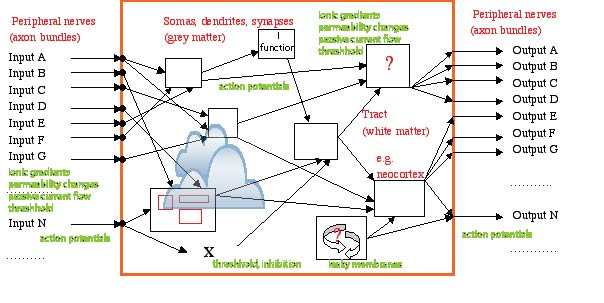
Is the brain a machine? a computer?
- "salt running in and out of channels"
- multiple interacting processors
- combined analogue and digital processing
- use dependence, no clear hardware/software or processing/memory distinction
- both local and broad band signalling
- internal autonomy, randomness
- "I-function"? itself "salt running in and out of channels" (and therefore can affect other boxes)
- functions not visible in elements that appear because of higher level architecture
Problems solved, new issues raised ...
- got inputs, outputs, boxes inside boxes
- got signals starting in middle, ending in middle
- got "I-function" as box
-
- report of internal state
- effect of external event on internal state
- action based on internal state as opposed to simply external state or "causeless"?
issues of "self", "consciousness", "free will" not avoidable - if such terms didn't already exist, we'd have to make them up to make sense of studies on the nervous system ... "I-function" one way into them
-
- got general sense of how smallest boxes work
- integrators, with own contribution
- anatomical specificity, local information transmission
- pharmacological specificity, local and more global information transmission
- modified by their own activity/function
- implies all aspects of behavior/experience correspond to patterns of action potentials in neurons (modifiable by hormones, drugs, etc). Important "micro" base but also already some important "macro" understandings. Behavior/experience
- involves distributed patterns of activity
- changes due to its own activity
- is sensitive to chemicals
- does not always have an external cause
- may be as much a function of inhibition as excitation
Continue discussion of architecture (non-traditionally) with output - "action"(since not all outputs can be accounted for by inputs and, it will turn out, outputs can affect both inputs and the processing of them, the nervous system, like science, is "loopy")
|
Action = "motor symphony"
A new concept: the reafferent loop Accounting for motor symphony
|
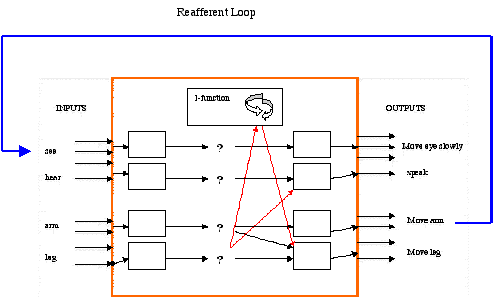
|
Reafferent loop - exteroreceptors and proprioceptors
- includes
- joint receptors
- Golgi tendon organs
- Muscle spindles - stretch "reflex"
- raises interesting issues about ns/behavior, I-function
- more looking backwards/upside down: NS generating outputs to get inputs?
- "Maybe
a leaky membrane in my mind causes me to think of neuroscience question
in class...and THEN I generate my motor output (writing down the
question), which allows me to have visual and tactile input (my written
characters themselves) ... Jackie Marano
- How many "senses"? Why traditionally 5?
- General issues to be returned to - stretch reflex relevant in re earthworm locomotion (among other things)
Preliminary human evidence?
- "central pattern generation" but ...
Looking more closely at the "central pattern generation" hypothesis
Implications of earthworm case- Reafferent patterning
- Central pattern generation?
- NS has "five ways to do same thing", proving A does not disprove B]
17 March
I can remember one audition in particular where I was nervous and couldn't really focus. To deal with my nervousness, I ended playing the piece without really thinking about it; I was pretty much on automatic. That audition ended up being by most successful. I think basketball players also get it this automatic mode during games, where brain can react to surroundings and coordinate the body, but at the same time the players don't really feel like they're thinking ... Leah Bonnell
The reafferent loop is a pretty amazing component of the human nervous system. To be able to sense one’s own outputs and have such perception generate newly modified and ‘improved’ inputs is a very necessary and often overlooked aspect of our everyday lives ... ddl
Reafferent loops, as well as a large percentage of interneurons in the brain, almost make me think that the brain doesn't need to rely much on environment for inputs ... So is our interpretation of the world more dependent on our behavior and actons than the actual environment itself? ... fquadri
The discussion on the idea that the nervous system can create motor symphonies without the use of reafferent loops or external stimuli got me thinking about some of the little everyday movements of different people. Many people seem to be constantly making small, unconscious movements for no particular reason. ... I know a guy whose legs are always moving. Whenever he is sitting or laying down he unconsciously starts jiggling his legs. No external stimuli cause this behavior, and usually he doesn't even realize he's doing it until someone brings it up. Also, whenever I'm sitting I start wiggling my toes. These movements seem to serve no purpose and occur without thinking. Perhaps these are examples of a combination of pre-existing motor scores that the nervous system contains ... Crystal Leonard
I am wondering whether our body language, and facial responses, are a
"symphony" already programmed in because so much of it is unconscious ... Sam Beebout
we talked about how a motor symphony allows us to perform everyday
actions like picking up a coffee mug or opening a door handle. Are
motor symphonies also related to thoughts/patterns of thinking? Does
thinking have a "motor" component? Do people tend to think/process and
analyze information in specific ways based on stored motor scores? Is
education in any way responsible for helping us form "scores"? ... jlustick
The latest discussions we've been having in class makes me wonder how 'psychology' fits into the scheme of neuron's etc. I know that psychology has a lot to do with how the physical body works, but at the same time, a person's psychology almost feels like it should be about 'the soul'. I guess I'm still confused as to how the idea of a soul fit's in with everything and if it can in any way be separated from the activities of the brain ... aybala50
While I understand that neurobiology and psychology at two separate entities, I keep coming back to psychology ... Brie StarkMotor symphonies, reafferent loops, and central pattern generation

Crayfish -
swimmeret (female, male) beat (more)
- nervous system - more detail
- central pattern generation?
- common in lots of organisms, including humans
- may be genetic, or result of experience, usually both
- what/where are central pattern generators?
CPG as premotor circuits, interconnected neurons
Motor sympony lacks a conductor - coordinated performance of independent players (cf. Boids, flocking, fireflies) - efference copy = corollary discharge
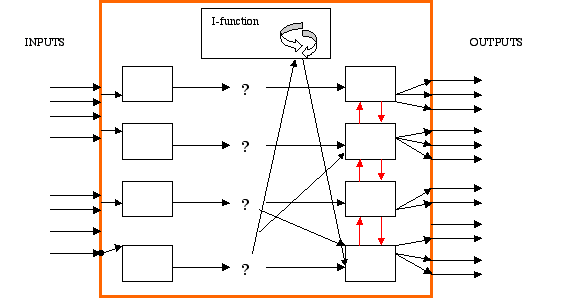
Look at some more uses/implications of corollary discharge:
- role in "perception"
- role in body sense
- comparison of expectation/input
- role in behavioral choice - Pleurobranchea
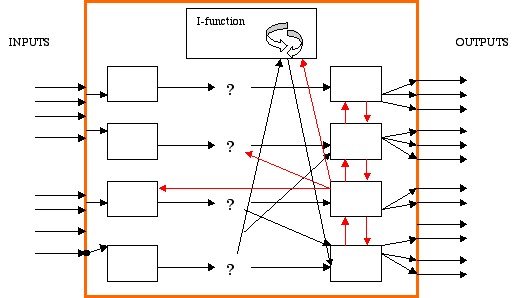
Can account in terms of neurons for
- Outputs related to inputs
- Outputs without inputs (CPG and spontaneous activity, "will"?)
- Different outputs for the same input (corollary discharge, "choice"?)
- Differing behavior in different people (genes, changes in ns due to its own activity)
Have still to account for
- consciousness
- culture
- reality
- purpose, meaning
24 March
From the forum
our discussion about efferent copies and corollary discharge has helped me to better understand this relationship between biology and psychology. It's fascinating that our brains are able to produce a copy of the efferent signals they send out and use this copy to determine if a signal is in reponse to an internal or external stimuli. And this ability to distinguish between self-produced signals and external ... [could] help us to become aware of internal thoughts ... bkim
how does this idea of coordination in the absence of a coordinator connect to human social habits and structure. Is it more "natural" for us to design a social system with a definite leader or not? How about our own desire to be leaders? Does the absence of a hierarchy within the brain somehow lead us to search for a hierarchy externally? Is our tendency to search for/create external hierarchy a downfall, a kind of unwillingness to realize that the most sophisticated systems (the brain, for example) do not operate in such a manner? ... jlustick
Our society is set up into section of leaders vs followers and teachers vs students because it a good way to learn. If everyone had to learn everything on their own from experience it would take forever to learn something new and any one mistake could be fatal ... Percival52
I really like diversity (even if it causes problems, culture shocks, distrust and forces you to move beyond what you know), but sometimes I’m afraid we are losing our diversity ... ilja
I was thinking about the implications of the independent, but communicating boxes model of the nervous system. In the absence of a director, how is a conflict between one or more boxes adjudicated? Is one box right and the other merely wrong? Could conflict be more than a prelude to violence or judgment? Might the conflict between two boxes be a sort of opportunity. A chance for creativity or making conflict generative. At its best, the brain is skeptical; it suspends judgment in a conflict between two boxes. The brain “listens” to the competing stories and combines the useful elements into a synthesis, a new story ... jrlewis
I also have never thought of pain in the way of an 'out of the ordinary' response with which the brain does not know how to process. In many ways, though, it makes sense. On a personal level, I know that when I'm on an airplane in flight and I close my eyes, I get nauseated for a few seconds because my brain tells me that I'm flying a steady path but my perception feels a slight plummeting feeling ... Brie Stark
there is still something I do not understand. I still don't get how all this adds up to me, to us, to a thinking, individual person. Where does intelligence fit in? Or personality? Where am I in my own brain? ... eglaser
There does not seem to be one “self” one “essence” directing the rest ... ilja
If the brain is what creates everything and controls everything, then how is it that it can be tricked? ... aybala50
I think in some ways, learning about the reafferent loop, corollary discharge, and pattern generators are growing my understanding of some of the more basic aspects of psychology. But I wonder how these components of the nervous system can connect to more multi-layered psychological occurrences, such as depression, the Oedipus complex, bipolar disorder, etc ... Sarah Tabi
Have some useful "boxes"/concepts from thinking about output side in
terms of possible origins of motor symphonies ... and some new questions
Output affects input ... input affects output?
Let's reinstate reafferent loop, see what new things that gets us
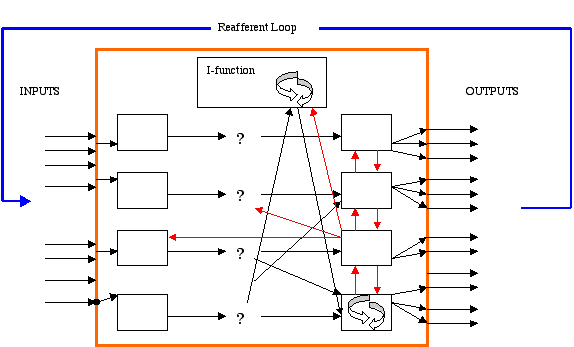
Stretch "reflex"
I. Not an input-output pathway but a feedback loop- input causes output; output causes input - no "simple" cause/effect
- negative feedback - stabilizing, "purpose"?
- thermostat - variable setpoint
- temperature regulation
- weight control
- others?
II. Getting it less wrong - comparison of what one expects from an action with the results and updating
| Linear science | Seriously loopy science |
 |
|
Adaptation in the vestibulo-ocular reflex and saccadic eye movements
In search of the I-function
Many more boxes/tracts relevant to output side of nervous system (alternate) - more and more
Cerebellum, basal ganglia as "loops"
- Cerebellum and "motor learning" (without the I-function)
- Motor imagery (the I-function without action)
Focus on motor cortex
- Somatotopy (topographic organization) - "upper motoneurons"?
- frogs don't have motor cortex - not needed for movement?
- decerebrate rigidity, spastic paralysis
- human
- cat
- three-toed sloth
Role of motor cortex?
- inhibition
- fine motor control, exploration?
- "voluntary/involuntary movement" distinction - with/without "I-function"?
Recapitulation: (looking back)
 |
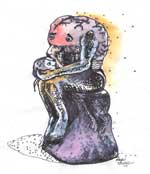 |
Lessons learned "from the output side":
- There ain't nothing there but neurons (ion flows, permeability changes, transmitters ...), interconnections among neurons, information processing
- Action = motor symphony = spatio-temporal pattern of activity across lots of motoneurons
- Symphonies may be based on internal scores and/or afferent/reafferent signals (usually both)
- Symphonies may reflect prior inputs and/or genetic information (usually both)
- Symphonies may be endogenously generated and/or triggered by inputs (frequently both)
- Inhibition plays an important role in determining what symphonies are played
- Symphonies frequently involve distributed performances with corrollary discharge signals creating coordination
- Outputs affect inputs and their interpretation, both via the outside world and via corollary discharge signals
- Corollary discharge can create elements of what appears to the external observer to be "choice"
- Feedback organizations can endow systems with what appears to the external observer to be "purpose"
- Action can occur without involvement of the "I-function" or the neocortex
- Damage to neocortex abolishes the ability to create "voluntary" movement but not the ability to generate motor symphonies nor to do so in complex and "adaptive" ways in response to sensory input (relevant to the Terri Schiavo case?)
31 March
From the forum
Why is it that an area like the medulla, which is usually thought of as a primitive part of the brain can make someone walk, while the neocortex, which is supposed to contain amazing things like morality and reason can’t even produce a coordinated movement. I’m guessing that because most coordinated movements do not required the I-function (walking, picking up an object, etc.), the I-function may not be located in the “lower” parts of the nervous system, but rather in the neocortex ... bbaum
I have a friend who sleepwalks, and when I saw sleepwalks I mean that she has actually left her house before and started walking along the road ... she goes through very complex movements and situations, all while asleep. How does this play into what we already know about movement and the brain? We have established that you do not need the I-function to have movement (even complex movements) but when a person is asleep shouldn't that prevent movement? ... eglaser
I really like the new observation that there is no central source of authority in the brain. Thinking about the brain as a coordinated system does make more sense ... Our body language is a double reflection, sometimes an opposing expression, of what we are putting out into the world. When we are stressed out, our bodies are also stressed out, and vice versa ... I am just realizing how seeing the body as a divided between many authorities in conversation with one another makes our sense of self a dynamic ... Sam Beebout
How much control do I have over my set point? It seems that eating/exercise habits may be partially rooted in the subconscious (for example, emotional eating or individuals who just cannot get the motivation to exercise), so maybe the set point is embedded in that part of our brain. Therefore, individuals who decide to lose thirty pounds are only changing their conscious set point. How might one change the unconscious? ... I'm wondering if set-points might play a role in other areas of homeostatic regulation. For example, mental states like happiness or depression. Might people have a sort of mood set-point? Does medication change that set point or simply ignore it? ... Do we have more control over our physical selves than we imagine or less because we need access to our unconscious to achieve this control? ... jlustick
Why does a person eat comfort foods to maintain good moods? Can our box theory explain this dependence? ... Lisa B.
After this class though I started thinking about individuality differently. What if these ideas about randomness of behavior, the unconscious part of our learning and coordination within our brain would actually account for our individuality? Following the Harvard Law of Animal behavior it might be that the coordination between different parts of the body, the fact that we do not have one place for movement but several, actually accounts for diversity. The unpredictability and influences of all the different factors gives an individual the freedom to explore and expand on what he/she knows. Since nothing is set in stone, and since we learn through experiencing new things and comparing the inputs with the outputs in our reafferent loops we create our individual selves ... ilja
if everyone in the classroom was pinched on their hand, their hand will immediately pull away. I’m starting to wonder if a huge chunk of individuality is embedded into emotions, and how much emotions affect reafferant loops or other future outputs …. Some may be angry and want to confront the source, others may be angry but not confront them, some may be confused and want to know why he or she was pinched, and others may just be shocked but move on. What accounts for such variation? Can we say it’s because of genetics, nurture/environment, both, or something about the I-function? ... fquadri
I realized that now I almost have 2 different brains that I can switch on and off with will. If someone asked me a controversial opinion question my answer would depend on whether I am thinking about it as a Turkish person, or whether I'm thinking about it as an American ... aybala50
I propose that the I-function could be a filter as opposed to a box ... drichard
It is not a box that is always part of a certain behavior pathway, but it is a filter that can be taken our or put back in. For example, the pathway that causes people to perform some kind of engrained, habitual behavior, such as biting their nails, can occur with or without the I-function. It is the same behavior of biting nails, but it can occur with and without the person knowing what they are doing ... bkim
blinking is considered an autonomic function that people rarely think about. However, if something or someone in the environment primes you to think about blinking, you will inevitably become more aware of when you blink and when you don't ... I'd also like to look at how the I-function relates to decision making and how it has the power to redirect actions (if it does at all). In other words, does the I-function have the power to sway how we interpret input and therefore ultimately affect our outputs and responses? ... kenglander
 |
 |
Lessons learned "from the output side"
- Neurons, interconnected boxes can indeed help us make sense of behavior
- patterns of activity
- genes/environment/spontaneous activity
- distributed system
- corollary discharge
- feedback loops
- processes with and without "I-function" involvement
Coming in from the sensory side - different/similar/additional?
Recall sensory neurons (specialized permeability changes) constrain "view of reality" - ns only "knows about", "can respond to", "has information about" things it has specialized neurons to transduce signals about- The "classical inputs": Seeing, hearing, smelling ... touch, taste
- Additional inputs, including proprioception, pheromone detection, and ... ?
- Extra-sensory perception?
- Info the nervous system has without the I-function about it?
- Information from sensory neurons neuroscientists don't know about?
- Information that "self"/"mind" has which doesn't come through sensory neurons?
- telepathy
- remote viewing = clairvoyance
- precognition
- Science and Spirit
- The Physical and the Spiritual: A Conversation About "How To Get Through the Veil"
- Further evidence, in any case, for "encapsulated" I-function
Interesting extensions of central origin of perception
|
- Good first approximation but ...
- Pain?
- Synesthesia - more
- Complication of "perception" ... "I-function"?
- Stay with labelled line idea, one modality
Vision as a paradigmatic case (is it? ... is at least best studied, and shows some general principals)
- "Seeing" vs light-detection
- Critical feature is information about differences, in this case differences in light arriving from different locations
"Imaging" - essential role of non-neural structures
- pin hole aperture
- refraction, optics of eye - near and far sightedness, alternate
- creates one to one correspondence between direction in space and location on retina
- creates appearance of light going in one direction rather than all directions; don't see "reality", see "images"
Have "picture" on retina, "picture in head" - What is the relation between the two?
- Size, stability, clarity, completeness of "picture in head"? Of picture on retina?
- Important details of retina
- fovea
- optic disk = nerve head
- nerve head more closely examined
- picture in head NOT picture on retina ... among other things, parts "made up"
- Additional insights into "I-function"?
Look in more detail at retina and interconnections to get more idea of how much picture in head is "made up" ... and why
- reminder of retina as three layers of neurons
- photoreceptors -> ganglion cells ... "vertical" and "horizontal" connectivity
- receptors good photocells ... ganglion cells?
- lateral inhibition network and its significance
- more "filling in"
- reality "more real" than apparent from input receivedI also find it interesting that the brain is able to convert2-D images on the retina into the 3-D images that we perceive in our minds.
- inbuilt presumptions about nature of reality
- in different worlds?
7 April
It seems pretty apparent that it would make more sense to have developed a means of visually perceiving the outside world in which no blind spots are found. So then why is it the case that such spots exist? ... ddl
The idea of the brain filling in gaps does make me a little nervous. People usually think of what we see as fact, when a lot of it is made up by the brain ... Leah Bonnell
it seems as if the brain not only fills in edges but is also able to create edges ... bkim
There is a big difference between thinking that you saw something & "knowing" that you actually did in fact see something, so how does the brain differentiate, if it does? .... bmcsoccer01
I'm wondering how our discussion of vision this week relates to dreams. We talked about how what we see is made up in part by our brains; our brain essentially fills in the gaps to make up for the holes in our vision. Vision in dreams is entirely a product of our brains, given that we are not receiving any visual input. Is the part of the brain that pieces together images in dreams the same part that fills in the gaps when we are awake? ... I am also curious as to whether the part of the brain responsible for images in dreams is the same as that which produces hallucinations. What is the real difference between the two? ... jlustick
Since what we see may be an "informed guess", does that signify that human beings in general are making the same guess in their minds? ... Sarah Tabi
I still can’t wrap my mind around the fact that we don’t actually see the objects in the world, but we only see the edges of objects. I had never thought about the world as simply changes in the intensity of light, but if I think about it now, it makes a lot of sense. I also find it interesting that the brain is able to convert 2-D images on the retina into the 3-D images that we perceive in our minds. I don’t understand what process is going on and where this process is occurring that is allowing the switch in dimensions ... bbaum
I have been trying to connect the edges metaphor to other sensory perceptions. Since its all about difference, its easy to see how it applies ... Sam Beebout
We established that we have more then 5 senses and all inform each other equally behaving as a check and balance system. Does that mean we should be able to talk someone out of their "crazyness" by reminding them of their other senses, to convince them what is real and what is not? ... Percival52Since the mind is able to "sense" things, is it able to sense the future without any direct inputs of what the future has in store? ... Jim Wiltsee
What is "reality"? Why isn't the nervous system organized so we see it?
From lateral inhibition : ns is organized to give us a "useful" picture, one that has worked in the evolutionary past
- What we see ("picture in head") is not "reality" but a "story", an informed guess about what is out there.
- Its an INFORMED guess.
Based in part on genetic information about what "worked" in past
- Plato's "ideal forms"
- Kant's "a priori's"
- I-function "picture" is generally based on processes unknown to it (but usefully discoverable?)
- The Brain's Images: Reflecting and Creating Human Understanding
- Getting It Less Wrong, the Brain's Way: Science, Pragmatism, and Multiplism
- Science as Story Telling and Story Revising
- Illusions, Ambiguous Figures, and Impossible Figures: Informed Guessing and Beyond
- From Five Senses to Synesthesia and Beyond
- We do not passively see objects, instead our nervous system actively constructs them
How to tell less wrong stories (guess well): using multiple perspectives ... to add location and depth
| Binocular stereopsis resolving conflict |
But ... creating ambiguity |
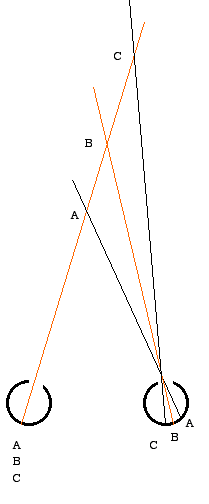 |
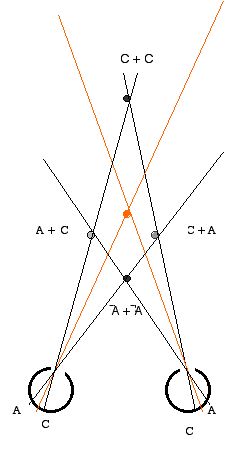 |
Better "picture" by making use of multiple perspectives, accepting/making use of "conflicts", picture in head a construction
Ambiguity as fundamental in seeing (Hofstadter's Road Sign), sensory systems generally
Can be reduced by using multiple cues, not eliminated (a "useful" gap?)- Picture in head could be otherwise
The issue of color,
This is not yellow |
or
When is red not red?
Physical "reality"
- Light consists of photons, intensity ~= number of photons
- Photons come in different wavelengths
- "White" = mix of photons of different wavelengths - alternate - alternate
- rainbow colors correspond to photons of different wavelengths
- colors of objects reflect absorption/reflection
- Retina - photoreceptors (two photosystems in humans, scotopic/photopic)
- Rods/cones and photopigments (alternate)
- dark adaptation
- Purkinje shift
- Trichromatic vision
- Color mixing(alternate)
- Land's color constancy ... more ... alternate ... Serendip
14 April
One of my friends is a fine arts major who is currently taking a painting class, one day she said to me, "I don't see white anymore, when I look at a wall it is never just white. Everything is full of color." When I look at a white wall, I see a white wall. We both look at the same object and see different colors, a perfect example of the subjectivity of sight and how the brain processes input. Is her ability to see color in white because she has more sensitive cones in her eye, or has she just trained herself to see it because of her painting class? ... eglaser
The idea that one person could describe a certain color that they associate with the term red as “red” while another could perceive a totally different color as their “red” is not that farfetched to me ... ddl
If colors are made up in the mind, does this mean that everyone can potentially have a different idea of what "red" or any other color looks like? ... bkim
most of the colors that we see in the world do not actually correspond to specific light waves and are fully constructions of our brains ... Crystal Leonard
If colour perception is a function of light, then the painter, in a sense, becomes (among other things) a manipulator of wavelengths ... drichard
do Schizophrenic patients see more of the truth than we, non-Schizophrenic people do? ... Anna Dela Cruz
Does a person undergoing psychological treatment, whether therapeutic or medical, exhibit a change in vision? ... jlustick
The most frustrating part of this is that we will never know what reality really looks like ... bbaum
If all scientific observations were assumed to be subjective, then "facts" would cease to exist. Scientific theories would all simply be suggestions. There would be no concept of a "right" or "wrong" answer ... Sarah Tabi
If our brains weren't similar enough to interpret the same data in a highly correlated manner then as a species we would have never agreed upon anything. It is important to have an orginal point of view but it is better to be able to agree on things .... Percival52
Society seems to have a conception that we must all conform to a specific ideal -- example, skinny in terms of body weight -- and yet, with this simple optical illusion example, we see that everyone perceives the world differently ... Following this line of thought, if everyone perceives the world differently, there doesn't seem to be a clear-cut line between "right and wrong" or "incorrect or ideal" or even "disabled or able-bodied." ... Brie Stark
While memory would seem to operate like a photograph, what we have discussed about the brain's constructions so far makes the mind more of a story teller ... Sam Beebout
What interests me is how the brain can combine guesses and information from different structures to create new ways of seeing ... ilja
Lessons from color and ...
- "color" is a function of brain, not of physical reality
- Add color contrast, like brightness contrast - Serendip
- Does a tree falling in the woods make a sound if no one is there?
- perception is different in different organisms (Goldsmith, Scientific American, July 2006)
- Most vertebrates have four cone pigments
- Most mammals have two
- perception different in different people
- Color "blindness" (alternate)
- Human tetrachromacy
- what is "real"? does it matter?
- what is "normal"?, the issue of "Culture as Disability"
- multiple perspectives advantageous? generative?
- sensory info, like motor output, coded across populations
- brain creates "platonic ideals" - "categories" which "work"
- a "gap" between the "physical" and the "mental"?
- allows creation of things which don't exist in physical reality - non-spectral colors
- is all done without the I-function
- there is a difference between knowing how to do something and EXPERIENCING doing something - a "crack"?
another hint about the existence of and role of the I-function?
relates to The Content and Epistemology of Phenomenal Belief, by David Chalmers, and Vision in a Complete Achromat, written by a vision scientist.
The picture in the head always an hypothesis, checked and rechecked ... ? The sky ... and the self ... and reality always an hypothesis? Where is the picture in the head, and what does all this have to do with the I-function/story teller? Could that be the doubter, the entertainer of previously unconceived alternatives? "reality" created by the story teller as a stimulus for checking?
- Disconcerting ... but also liberating?
- individual creativity
- value of interpersonal sharing
The bipartite brain: where is the picture in the head? the I-function/story teller?
Multiple ganglion cell types - frog
- contrast and color opponency
- multiple samples
- motion
Retinal projections ... another ... another
- multiple targets
- midbrain
- thalamus -> striate cortex
- different, parallel functions
Moving on to neocortex
Remembering some relevant comparative neuroanatomy - neocortex as parallel to rest of nervous system
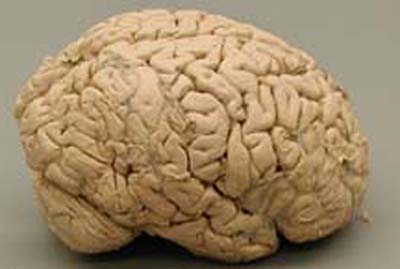 |
 |
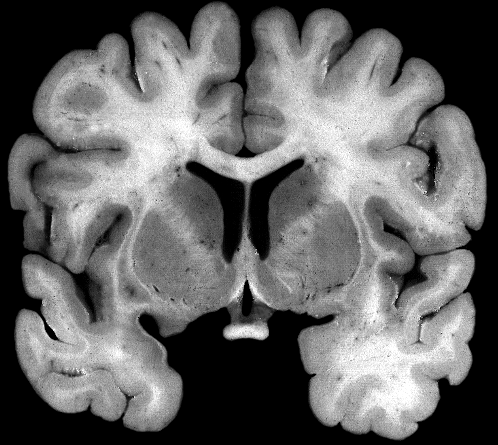 |
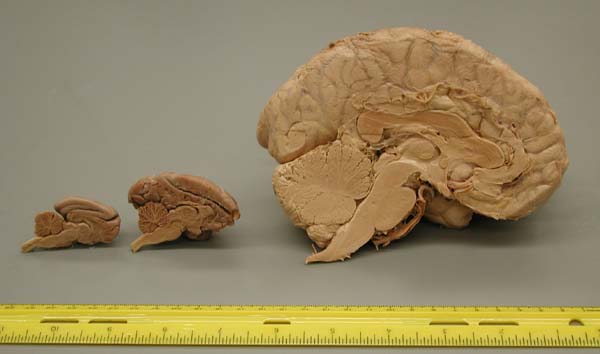 |
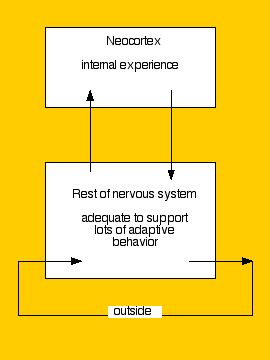 Visual Cortex - binocular convergence, altered "feature" detection, columnar organization, topographic organization
Visual Cortex - binocular convergence, altered "feature" detection, columnar organization, topographic organization
- Picture in head not in striate cortex
- parallels to topographic organization in motor cortex
- laterality re what looking at rather than re "self"
- unlike picture in head, representation in visual cortex moves when eyes move
- Color and motion dissociable
- Partial color deficits
- motion blindness
- face blindness
- Distributed "picture in head"
Blindsight and its implications - Don't NEED "picture in head"
- What IS "picture in head" for?
- internal experience
- Self as object
- I-function ("story teller"?) in neocortex? constructed ("story"), testable, reconceivable, "imaginary" and hence re-imaginable
 Lessons from sensory side ...
Lessons from sensory side ...
- distributed systems
- ns "creative", "reality" an hypothesis rather than a touchstone?
- distinction between responding and experiencing, I-function/story teller
- picture in head = pattern of activity in neocortex, thoughts/ideas?
- I-function/story teller relates to neocortex?
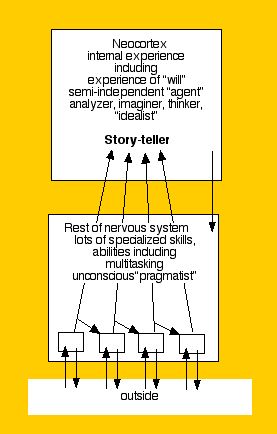
Further evidence for a bipartite architecture in other realms - generalized control mechanisms
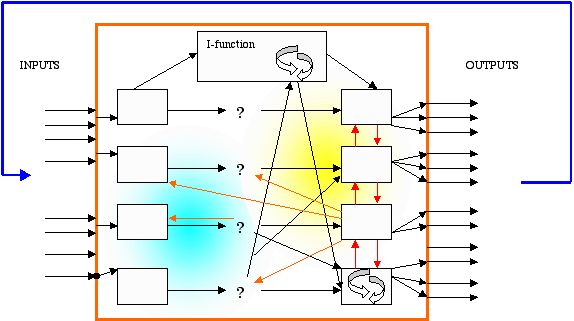 "generalized control mechanisms"
"generalized control mechanisms"
- wide spread changes of state
- pharmacological involvement
- degree of autonomy
- more on independence from I-function, on expectation generation
- more on I-function ("story teller") localization/independence
- human behavior without an I-function
- interplay of unconscious and I-function (story teller) to yield "self"
Schizophrenia
21 April
what happens with more extreme mood changes like severe depression or mania. Is it solely based on chemical alterations in the brain or is there and I-function/ environmental element to the creation of these problems? ... eglaser
Since I feel like there is an input and output for a person is sleepwalking I do not completely understand where all the information goes. They do not remember these nightly jaunts but they performed them, their brain was active for them, so where did the information go? Do they have an unconscious knowledge of what they did and are unable to access it? ... SandraGandarez
even though I have an I-function, it doesn't unilaterally control my descision making ... Percival52
I have come across the Freudian theories concerning the id, the ego, and the superego. The belief is that the id is the emotional or irrational part of the mind located deep within the subconcious. The superego, on the other hand, is the moral and perfectionist part of the mind located in the consciousness and arising from societal conditioning. Both the demands of the id and the superego can at times be unrealistic therefore the mind requires the ego to mediate between the two--to find a way to get what the subconcious wants in a reasonable manner. In relating Freud's theories to neurobiology, could the id be seen as a lack of connectivity between/among various parts of the brain, the superego as too much communication of these regions, and the ego as the coordination of these parts? Would Schizophrenic patients have an overactive id? ... Anna Dela Cruz
I was ... thinking about the brain's "story" this week. As opposed to a cut and dry, computer-like observation system, a story gives your reality meaning. It allows the human being to see purpose and to derive direction from what it is perceiving ... drichard
The Bipartite Brain: Further evidence and new directions
So far
 |
 |
- One can act without the experience of acting
- One can see without the experience of seeing
- One can be, distinctively, without the experience of being
- The experience of seeing is a construction, a story, an assembly built of many parts, somewhat arbitrarily and potentially different
- Also true of acting, being, and ... ?
One can have "emotions" without the experience of them ("feelings")
- Damasio
- psychopathology - thought without feelings
- Capgras syndrome (Ramchandran)
- feelings/intuitions a story, could be otherwise
- primary vs elaborated stories

|

|
One can be affected by experiences (learn) without the experience of having been affected by them (memory)
- dementia and the unconscious
- implicit vs explicit memory
- body language
- tacit knowledge
- memory a story, remade each time its experienced (Memento)
- Damasio: proto-self, core self, autobiographical self (cognitive unconscious, primary story, elaborated story)
28 April
While talking about the story teller we learned that it has a strong tendency to make things complete and coherent; this applies to the blind spot in our eyes ... This aspect of our brains causes a significant amount of variation among us, which ties into our discussion of earlier in the year when we were discussing how many brains it is possible to have ... Would I use a different excuse for walking around the table then the man in the experiment? ... Sandra Gandarez
someone who is neurotic may interpret the event of not receiving a response from someone they said 'hi' to as they were passing by as that person not liking them whereas someone who is extraverted may just think that the person did not hear them and accidentally did not respond. Thus, it seems as if our personalities do play a big role in what kind of story we tell ... bkim
I am interested in the connection between our calling the I-function a storyteller and Freud's conception of the "talking cure" which involves a patient being treated through the construction of a personal narrative. This form of psychoanalysis depends upon a patient actively playing the role of storyteller. What I realized in class, however, is that a person is always a storyteller. It seems that Freud wants the patient to include more of the information in the cognitive unconscious in the storytelling. In other words, storytelling, when performed in a sort of deliberate, introspective way, can be a vehicle for uncovering and making sense of the cognitive unconscious. Freud seemed to believe that a person's sense of self and psychological state depends upon their story...the way they've integrated and woven their experiences together into a kind of coherency ... memoir is only nonfiction in the way that it represents the author's current self ... jlustick
I started to think about the concept of a liar. What would constitute a liar if we create stories in order to account for changes in the cognitive unconscious for our memory? We even discussed how confabulators generate stories to make sense of information, so how can one accuse another of being a liar? Is someone a liar because their story isn't consistent with mine? ... Sarah Tabi
Looking back on class this week i was also reminded of what we said the first day of class, "there is no truth, there is nothing absolute." I think we came to an agreement that this statement isn't true, or at least incomplete. It seems that there are things that are true seperate from our perception of them, but we are unable to describe what those things are without bringing our own subjective perception ... Percival52
The idea of a story teller in our minds that completes thoughts that don't make sense to us is interesting because it takes the idea of truth to a whole new level. At the beginning of the semester we talked about the fact that truth does not exist, but until this idea of a story teller, I didn't very much doubt my own ideas and feelings etc. Now I realize that my own brain is making up stories to make up for what doesn't make sense, hence my own brain is lying to me. I can't trust my own thoughts and feelings ... aybala50
Sometimes when people are asked why their favorite movie, book, or painting is their favorite, they respond with, “I don’t know, it just is”. Are these preferences fueled by the unconscious emotion that the conscience is not fully aware of? I think so for the most part ... just because I accept the theory of the bipartite brain, it doesn’t mean I’m completely comfortable with it. It makes me wonder how many secrets my brain is hiding from me. In a way, it makes studying the nervous system more intriguing and fascinating. At the same time, it seems a little frightening living with this knowledge ... fquadri
researchers are trying to measure "unconscious bias" by analyzed test subjects' responses to varying situations. After the experiment the test subjects can become aware of their unconscious biases based on race, gender, and age ... This leads me to wonder how unconscious thoughts become conscious ... Leah Bonnel
I understand the idea of an object not holding any meaning until it is given meaning. I think many of the differences that exist between cultures arise because of differences in the meanings that we place on certain objects or concepts. This is also the reason that it can be so easy to offend someone ... This is why I believe that education about different cultural/religious groups is so important ... In order to live peacefully with everyone, weneed to have the ability to see an object in many alternative ways ... bbaum
I have been watching the new show Dollhouse. The premise of the show is that people are programmed with different people's personalities and that they pull from this person's memories and personality ... It seems like this concept of being able to program someone's personality is more science fiction than reality .... It doesn't seem possible to just program a personality because it functions as such a complex interaction between different boxes in the brain, indeed it is a fluid construction of the brain that doesn't seem easily removable or transferrable ... In the show there is a "sleeper doll" who is both programmed with a personality and programmed defensively to a verbal cue. I think it is possible to program this type of information into a person so that they respond to a stimulus, but don't know or consider why they are responding to it ... Sam Beebout
I find the idea of a bipartite brain very interesting. In fact, I was wondering whether or not it might be useful for understanding other mammals. Horses have a neocortex; therefore, horses have a storyteller element of their brain. I am curious about the stories horses’ brains tell. Are they similar or different to the stories human brains tell? ... jrlewis
we came to the conclusion that the story teller is not dependant on language, but that language was a tool with which the story teller could communicate its output ... Language is often ambiguous (for example, the word "love." what does love mean? many things). It seems that one of the functions of the story teller is to overcome the ambiguity already inherently present in the world so as to afford us coherent realities ... drichard
How do things end up in the conscious or unconscious? Which part of the brain chooses where the information goes and which part is more important? ... I also thought it was interesting how we stumbled onto similar discussions in terms of meaning (leading back to the question of whether something is there if there is no one to experience it) as we did earlier in the semester. I’m curious to talk more about culture and the example of the bipartite brain ... iljaTwo interacting systems
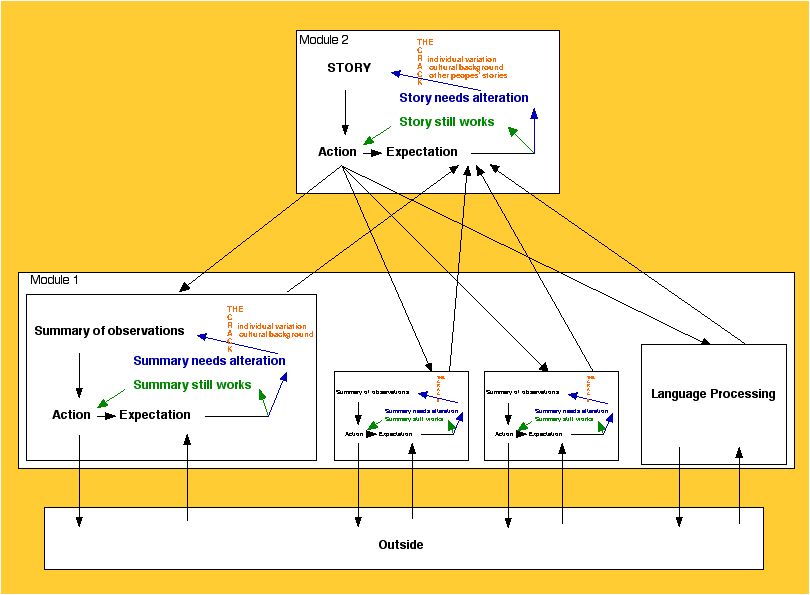
The bipartite brain and culture
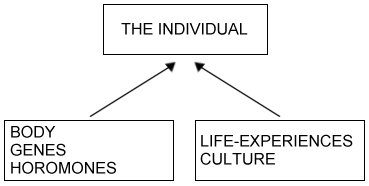
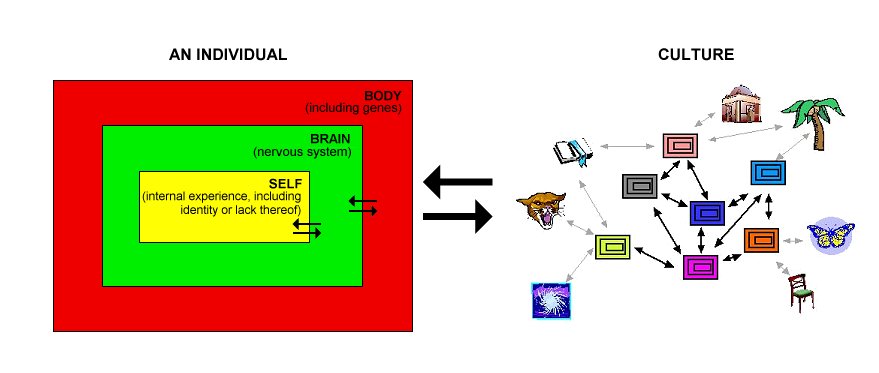
from The Brain and Social Organization
Interacting individual and cultural stories
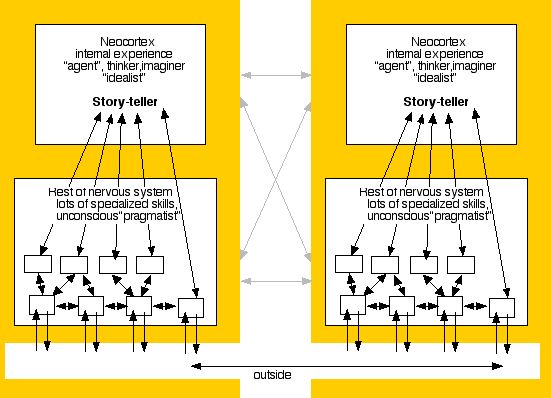 Advantages and challenges of the bipartite brain
Advantages and challenges of the bipartite brain
Learning to live with/enjoy the bipartite brain
Writing Descartes: I Am and I Can Think, Therefore ...Paths to Story Telling As Life
- Genes are valuable, but don't take them too seriously
- Experiences are valuable, but don't take them too seriously
- Feelings are valuable, but don't take them too seriously
- Cultural stories are valuable, but don't take them too seriously
- Personal stories are valuable, but don't take them too seriously
- Stop looking for the "answer" and look instead for what's "less wrong," for new directions to create
Bottom line of story of brain=behavior:
- Believe in where one is, has come from (including genes)
- Challenge self/others, dream/imagine/create
- Share stories
- Repeat over and over again
and what I find around me
Thanks all for contributions to the evolution of my story, and that of others. Keep enjoying the evolution of your own ...
To be continued

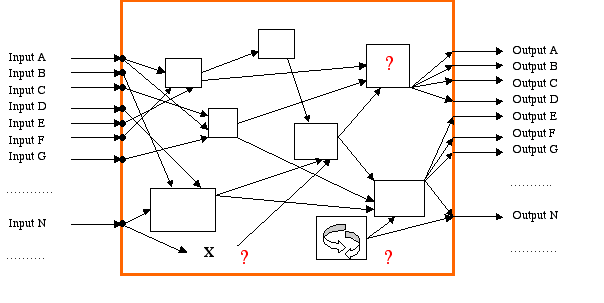


Comments
Serendip Pingback
[...] This page has been linked to from The Brain Without Behavior | Serendip's Exchange
[...]
Serendip Pingback
[...] This page has been linked to from Neural Epiphanies | Serendip's Exchange
[...]
Post new comment